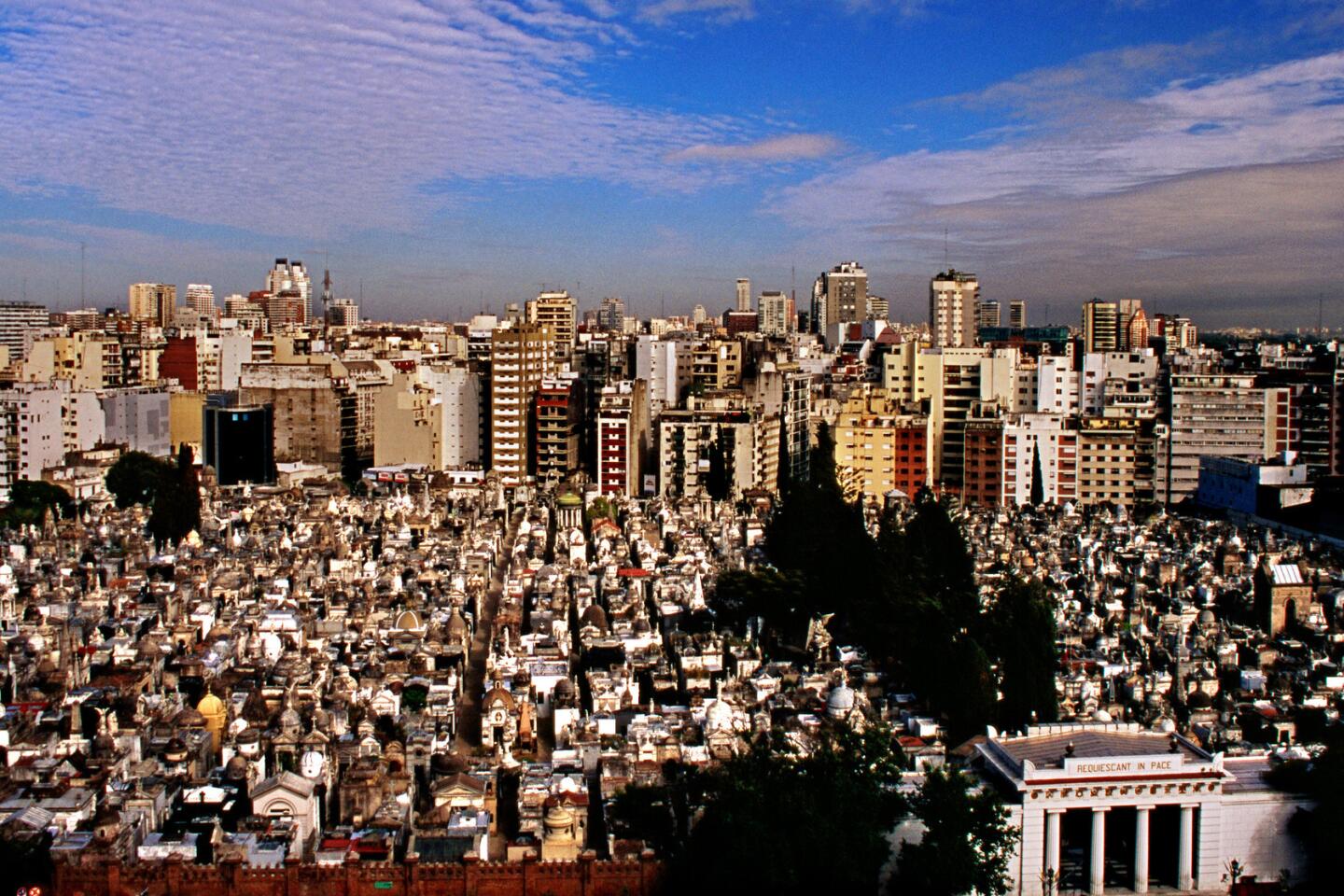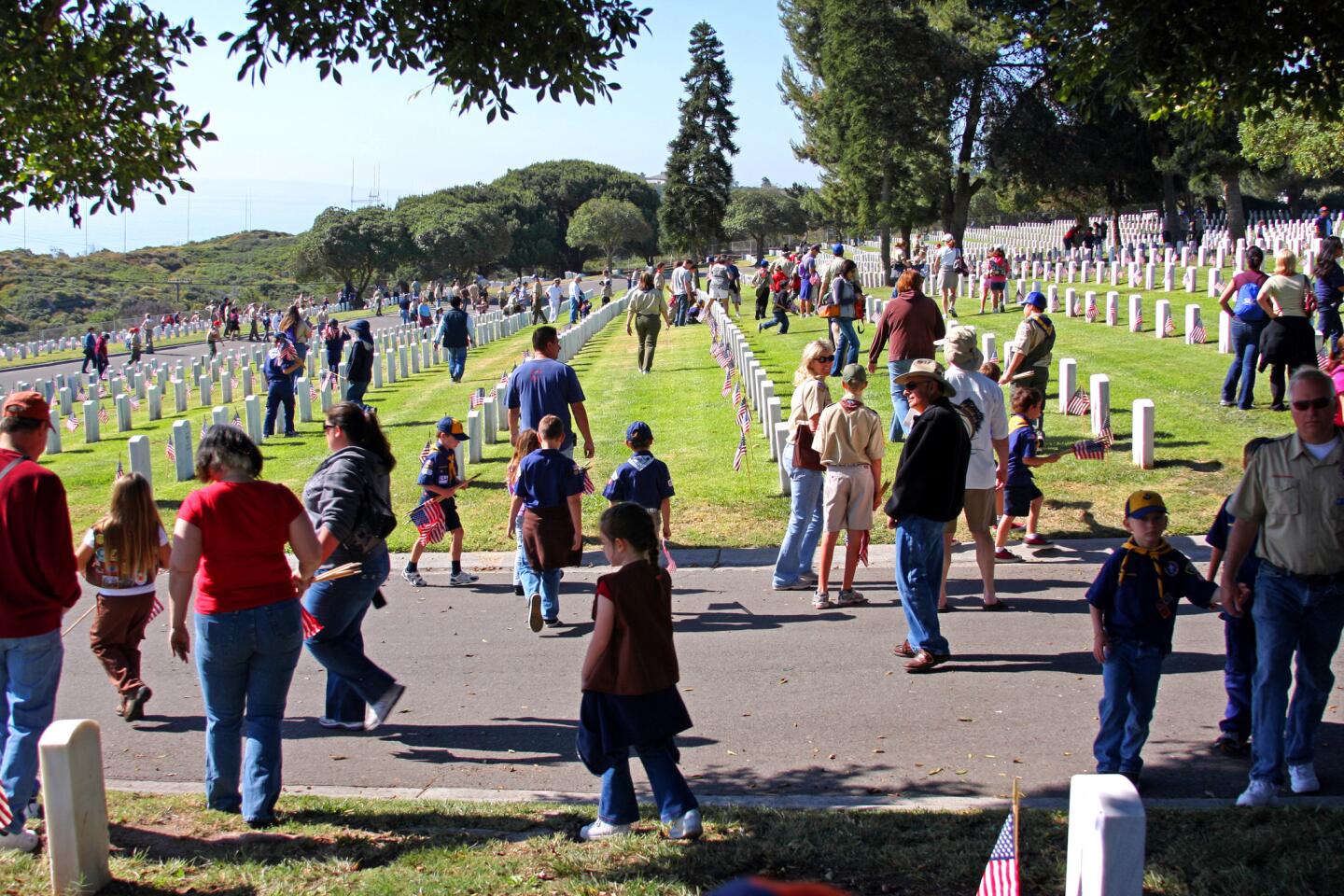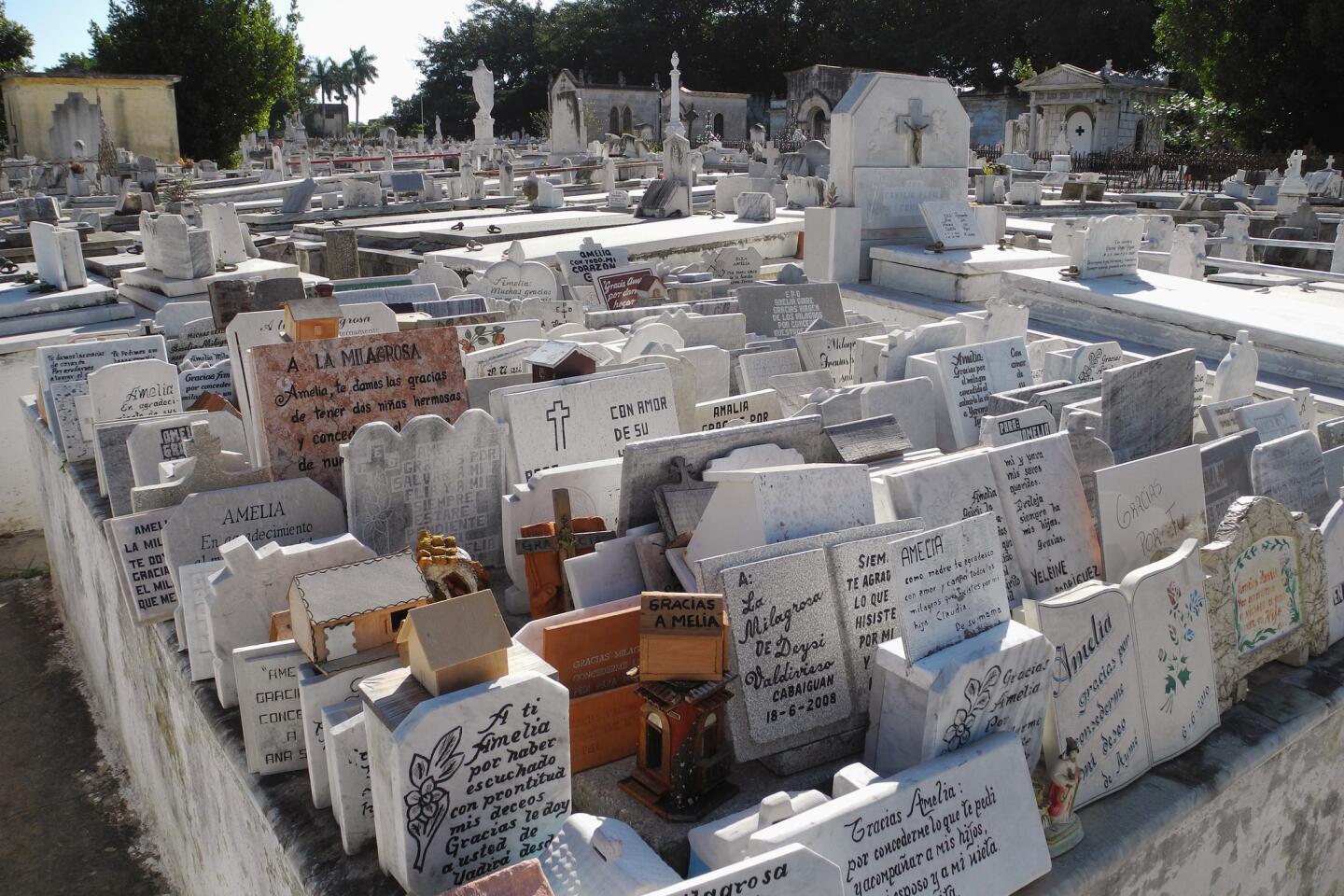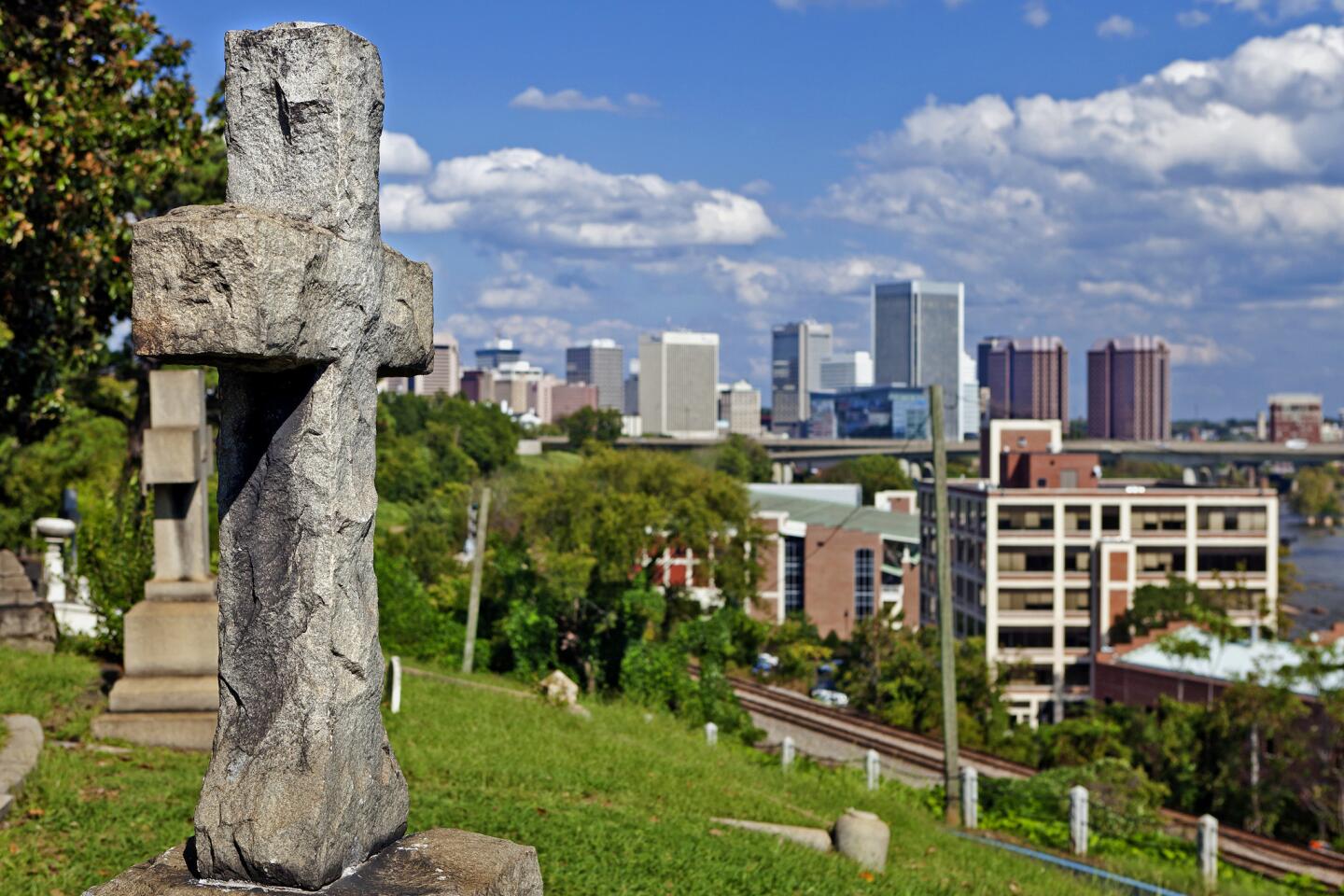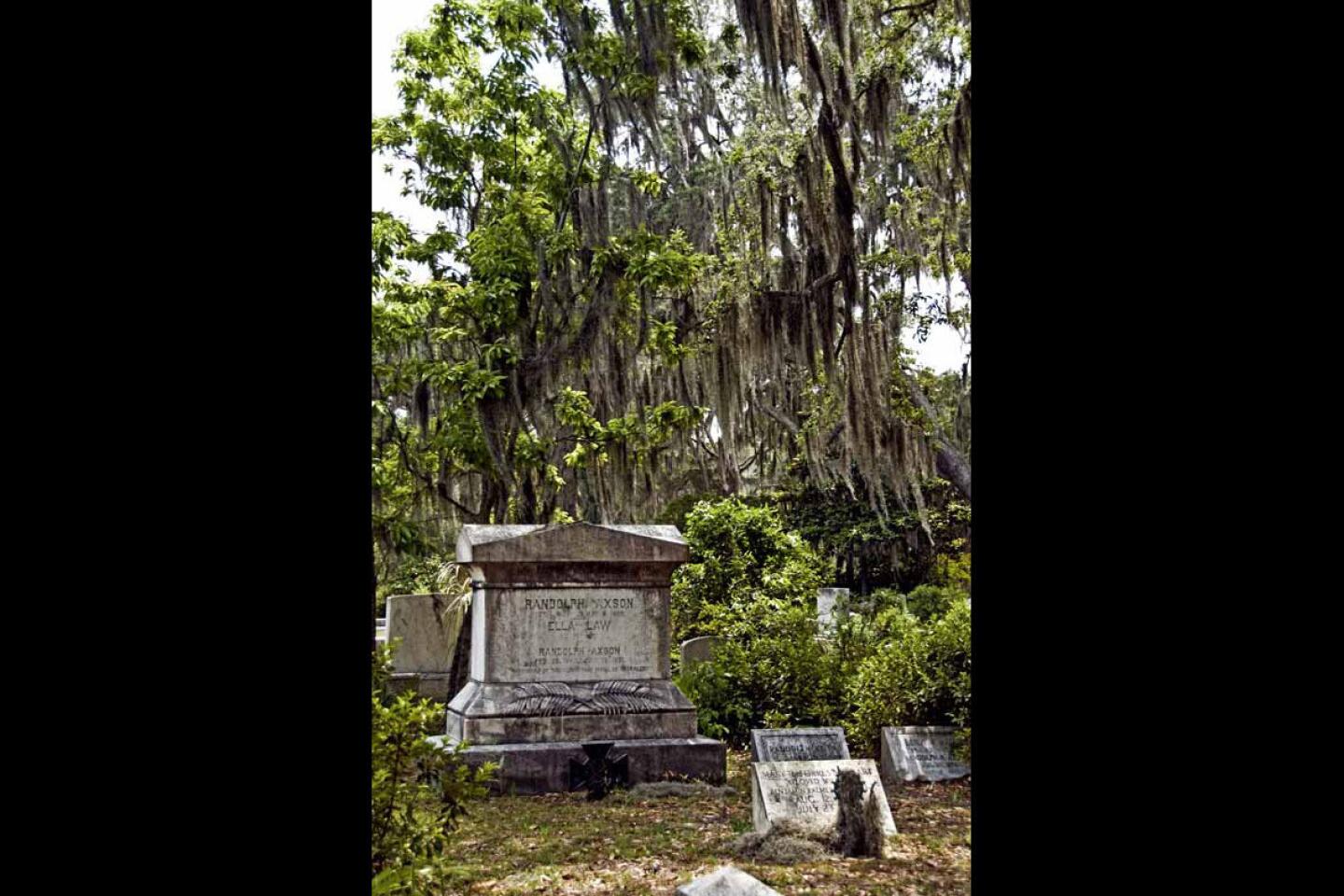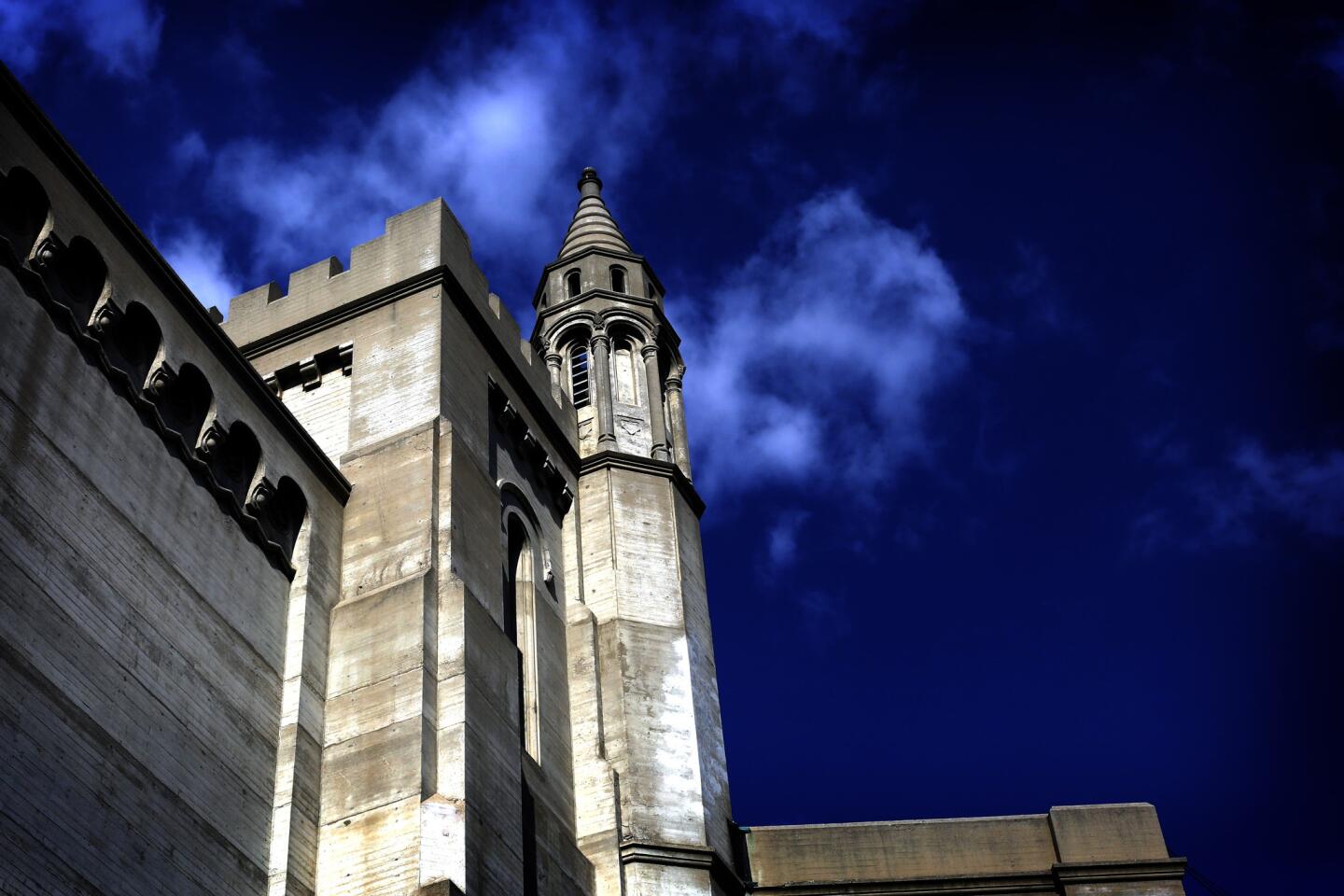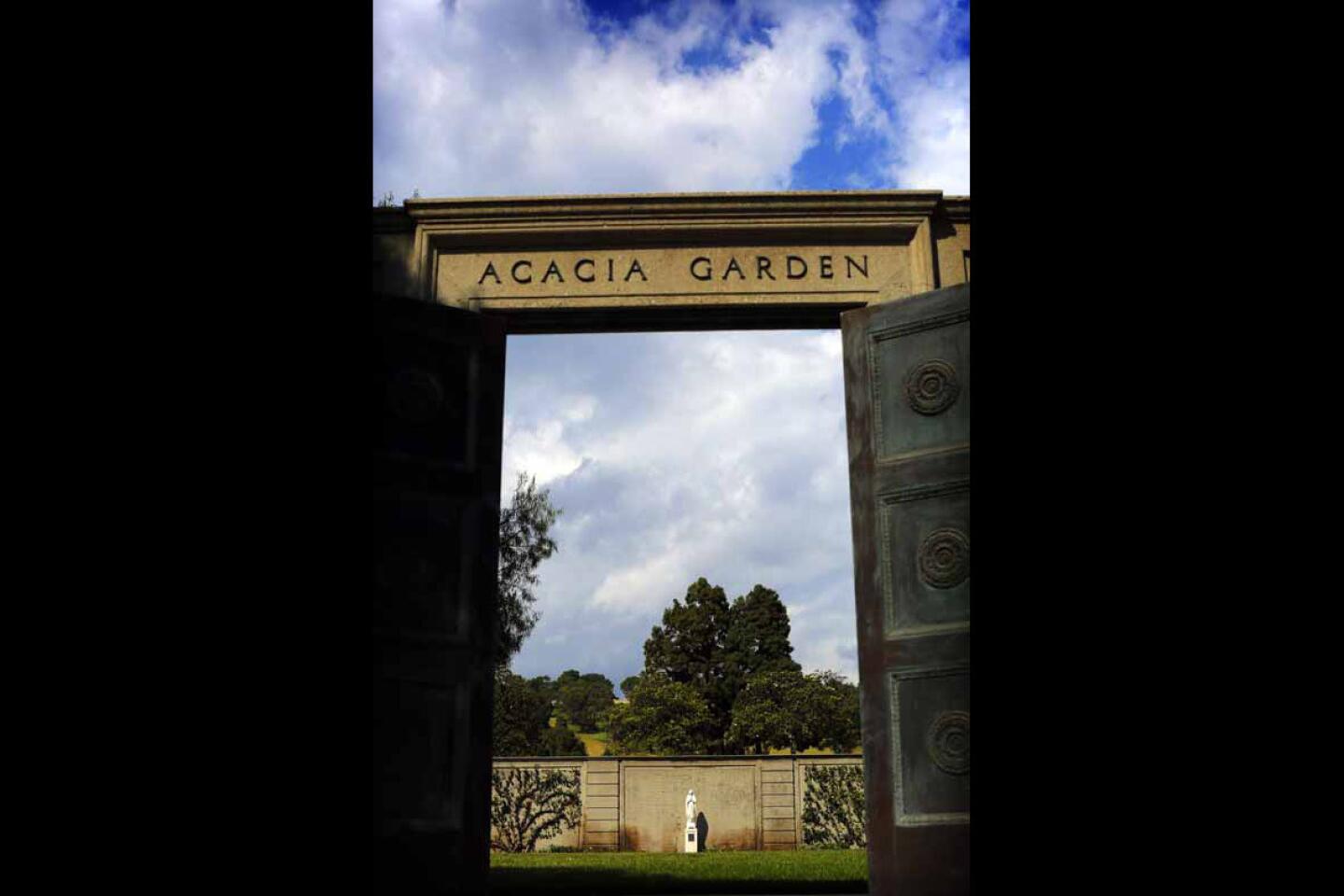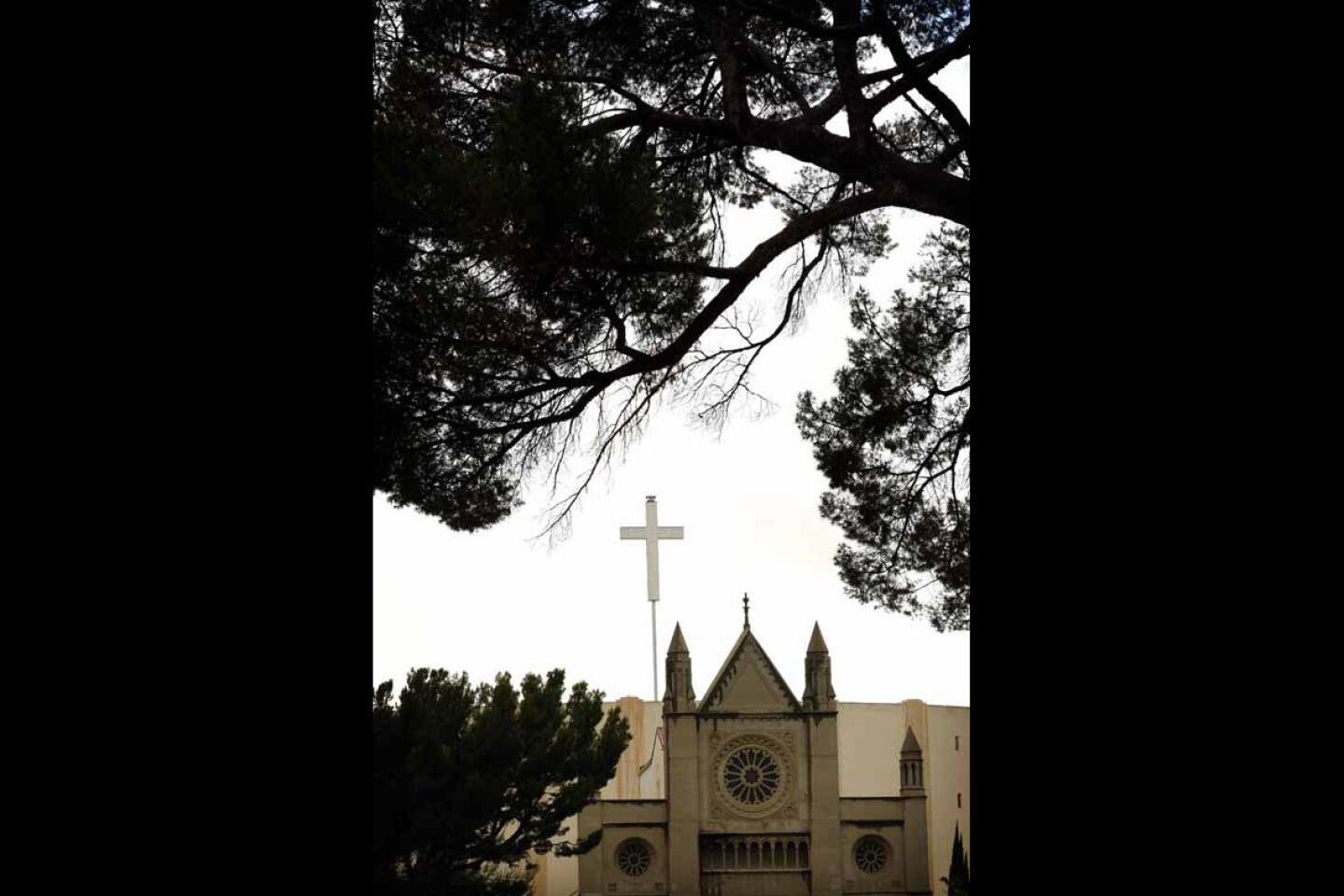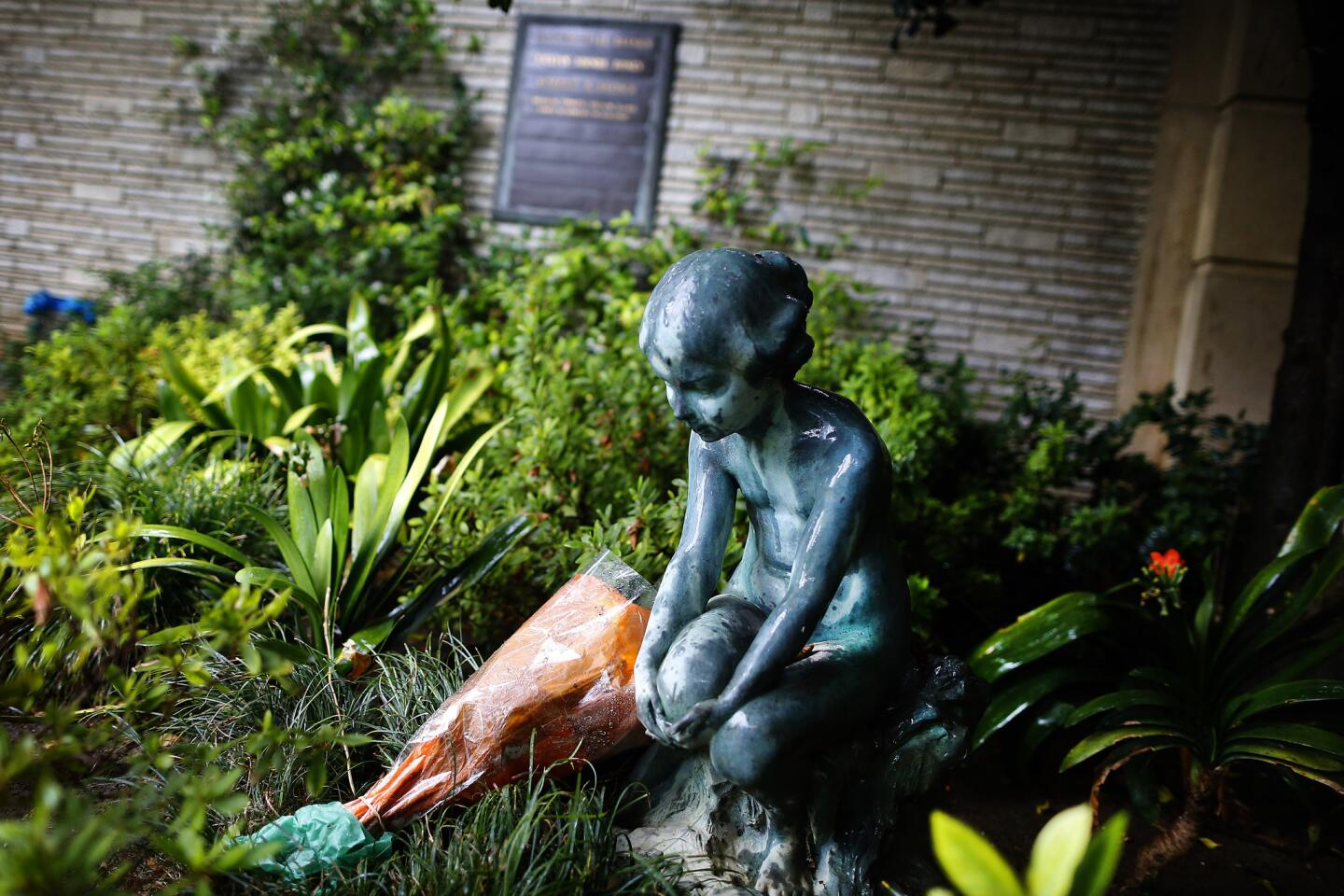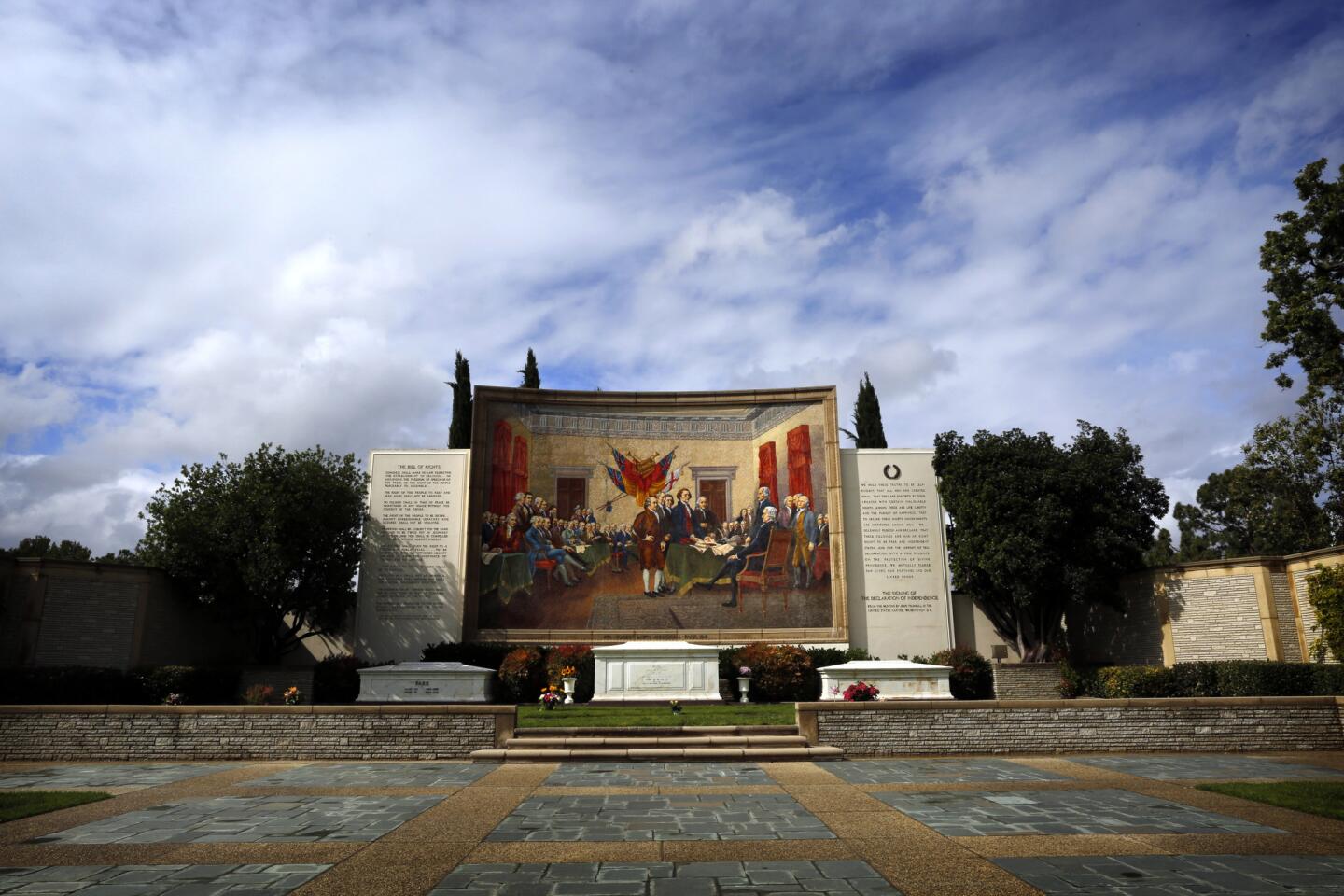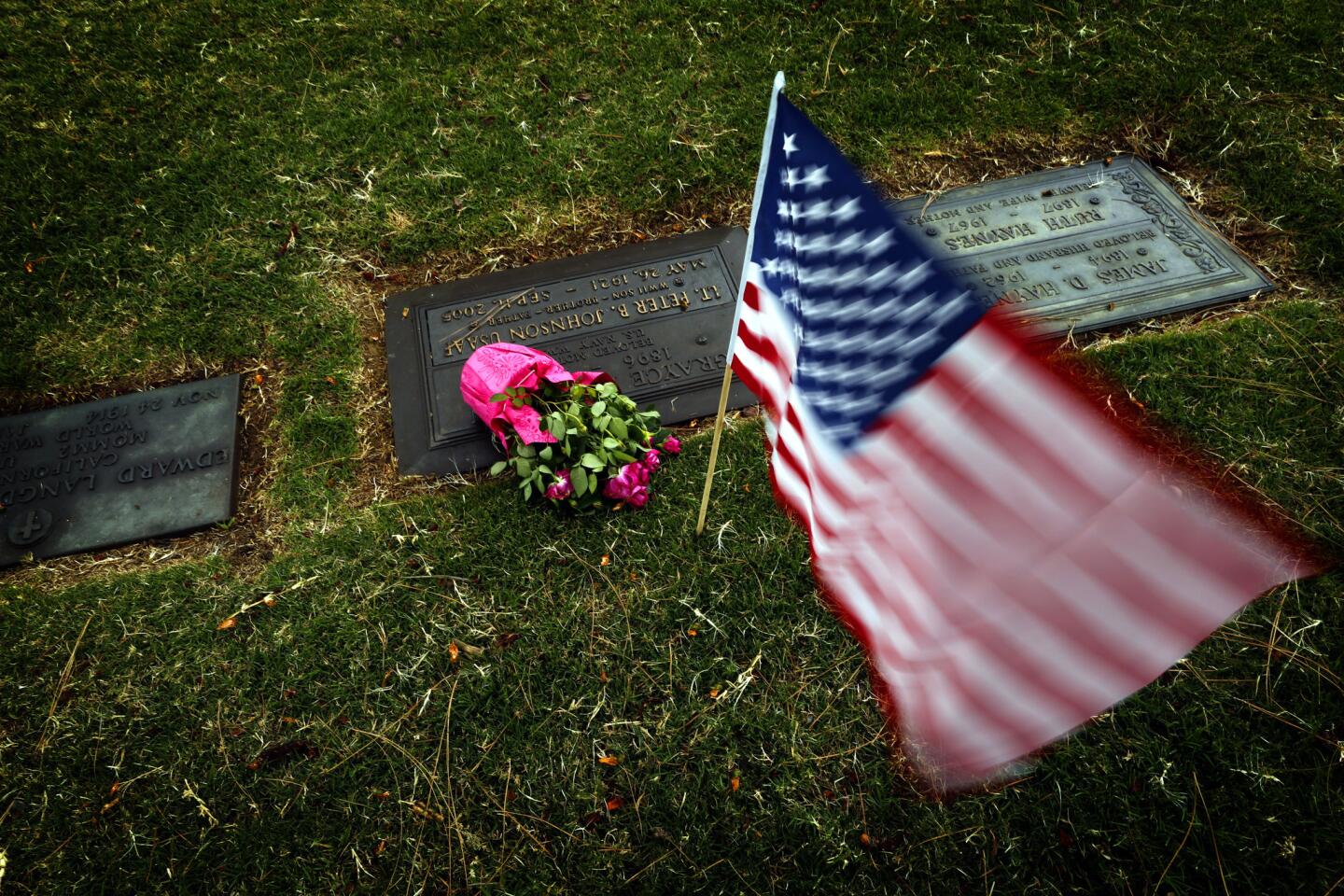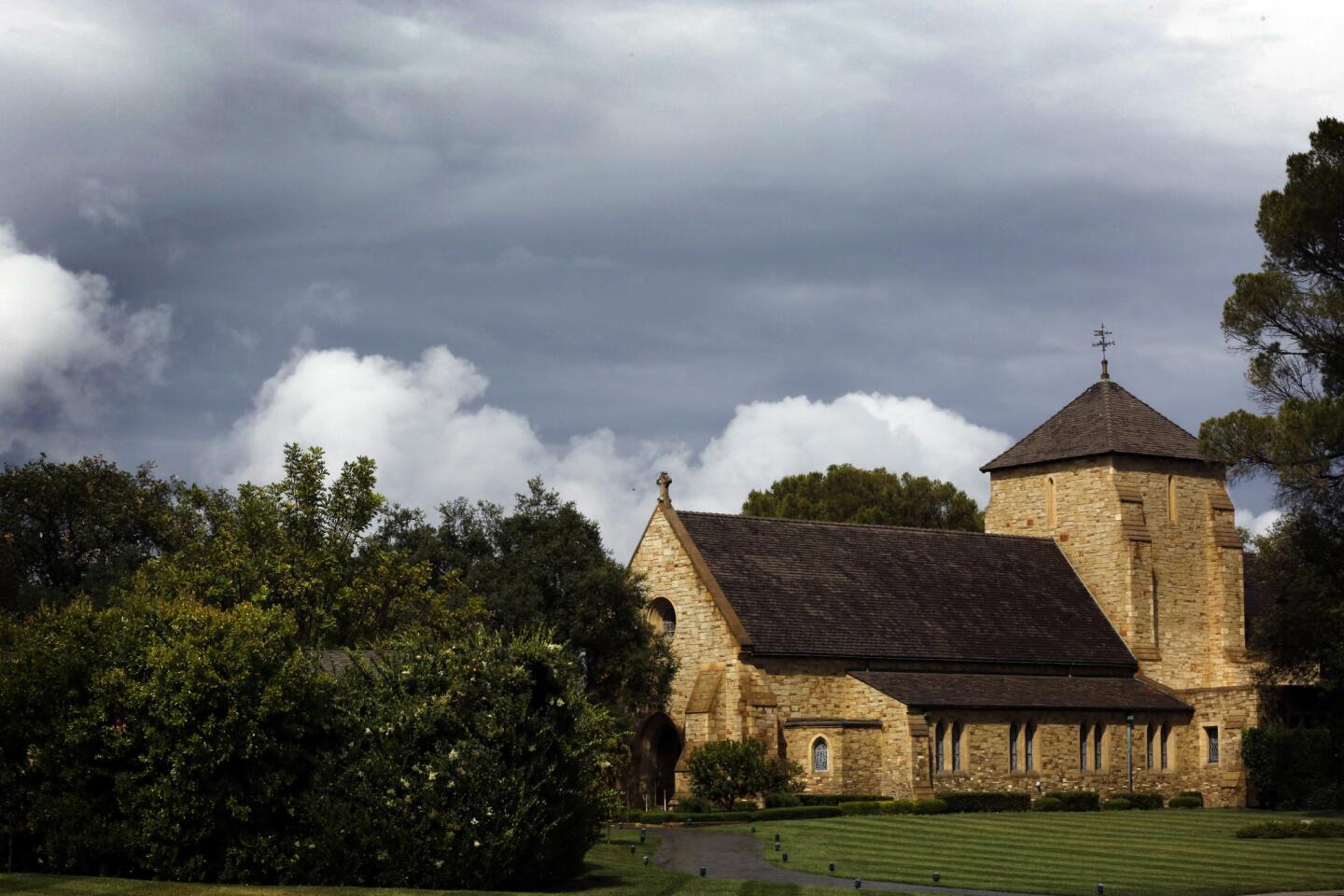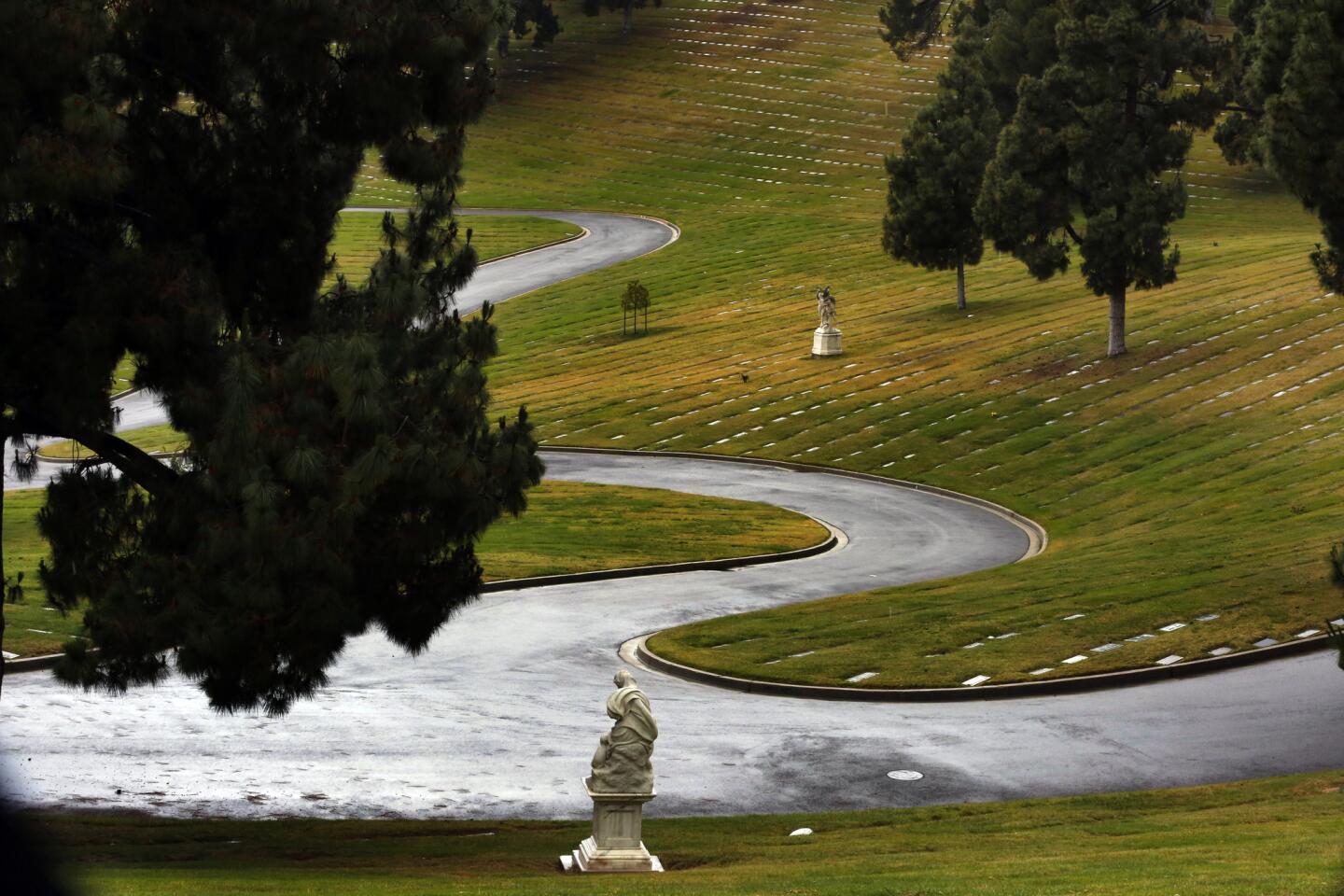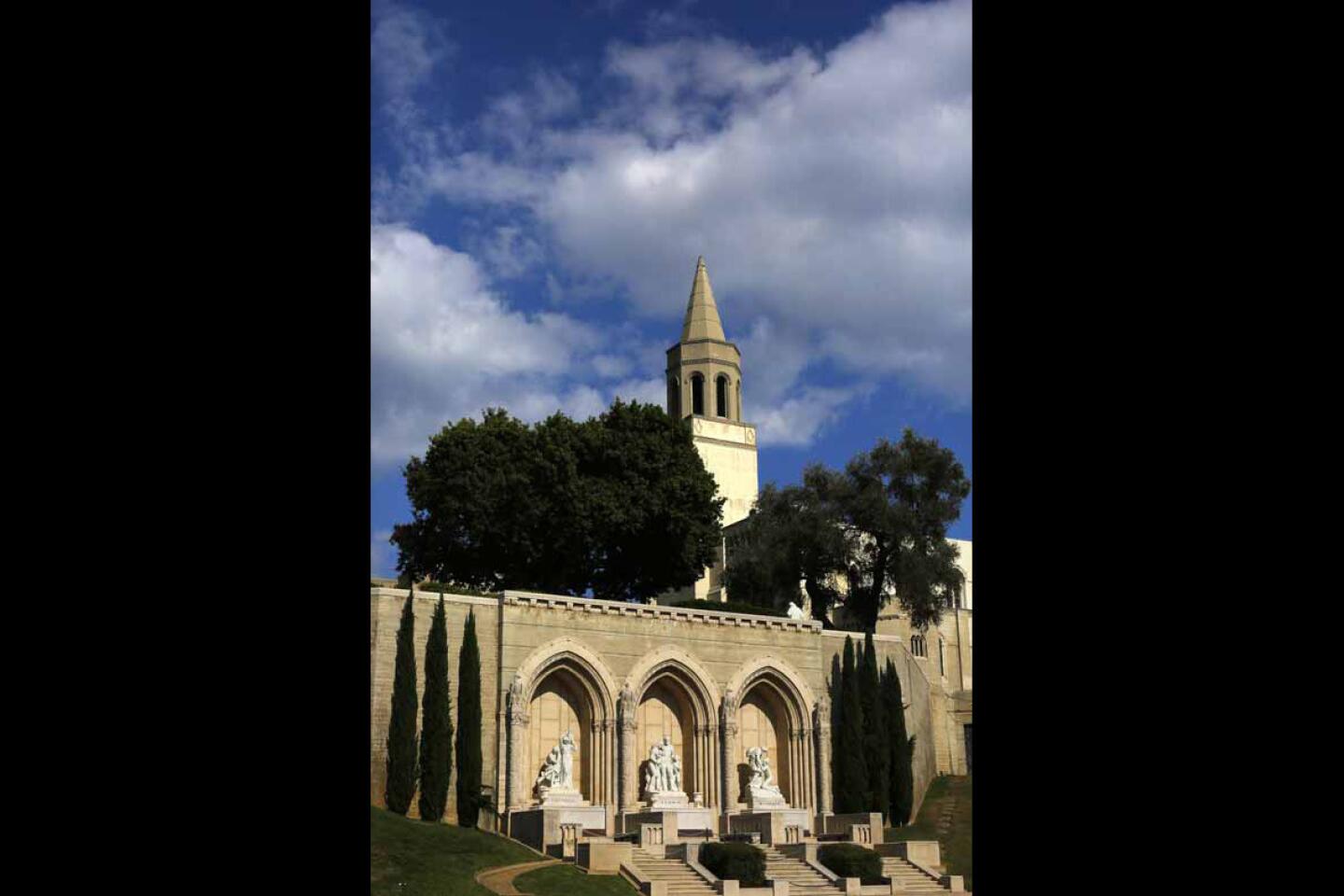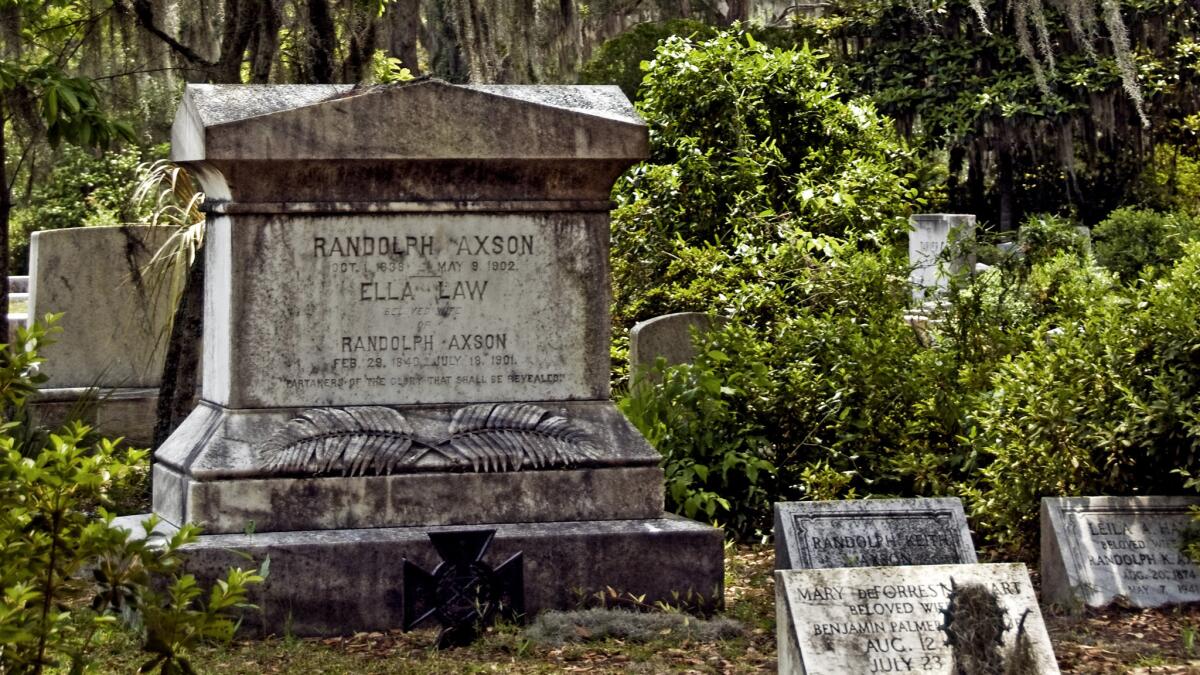10 cemeteries you’ll never regret visiting
- Share via
When my brother-in-law died unexpectedly some years ago, I was assigned the task of choosing a gravesite in California, to which he would be brought home for burial.
As I walked the grounds of Ascension Cemetery in Lake Forest, I was fairly certain I had seen a headstone with a picture of Wilma Flintstone.
Was it? I asked, fearing a stress-induced hallucination.
"Oh, yes!" came the reply. "That is the grave of Jean Vander Pyl, who was the voice of Wilma Flintstone. And William Hanna" — as in animation greats Hanna-Barbera — "is buried here too."
It fell to me to call my sister and ask, "Would you mind very much if your husband is buried near Wilma Flintstone?"
When we visit his grave, it is hard not to shout, "Yabba dabba doo."
The experience broke the spell that cemeteries once held over me and, indeed, hold over many of us. No matter our beliefs, the sadness in visiting these places — Nicole Brown Simpson is buried in Ascension — never subsides, but the fear can, replaced by an appreciation for life and history. If death is the final reminder that we are imperfect creatures, the impeccably manicured grounds try to balance the scales.
Below, 10 travel writers take you to burial grounds across the United States and outside the country. They invite you to remember military veterans, who inspired the Memorial Day holiday, along with actors, comedic and serious; a president's wife, both beloved and reviled; a mysterious mother and more.
Pay your respects or pay a visit; you'll get your reward, perhaps in heaven but definitely in the here and now.
Skip to: Alexandria | Recoleta | Forest Lawn | Hope Cemetery | Ft. Rosecrans | Bonaventure | Lafayette Cemetery No. 1 | Oak Hill | Hollywood Cemetery | Cementerio de Cristóbal Colón
ALSO: Celebrity graves in L.A.
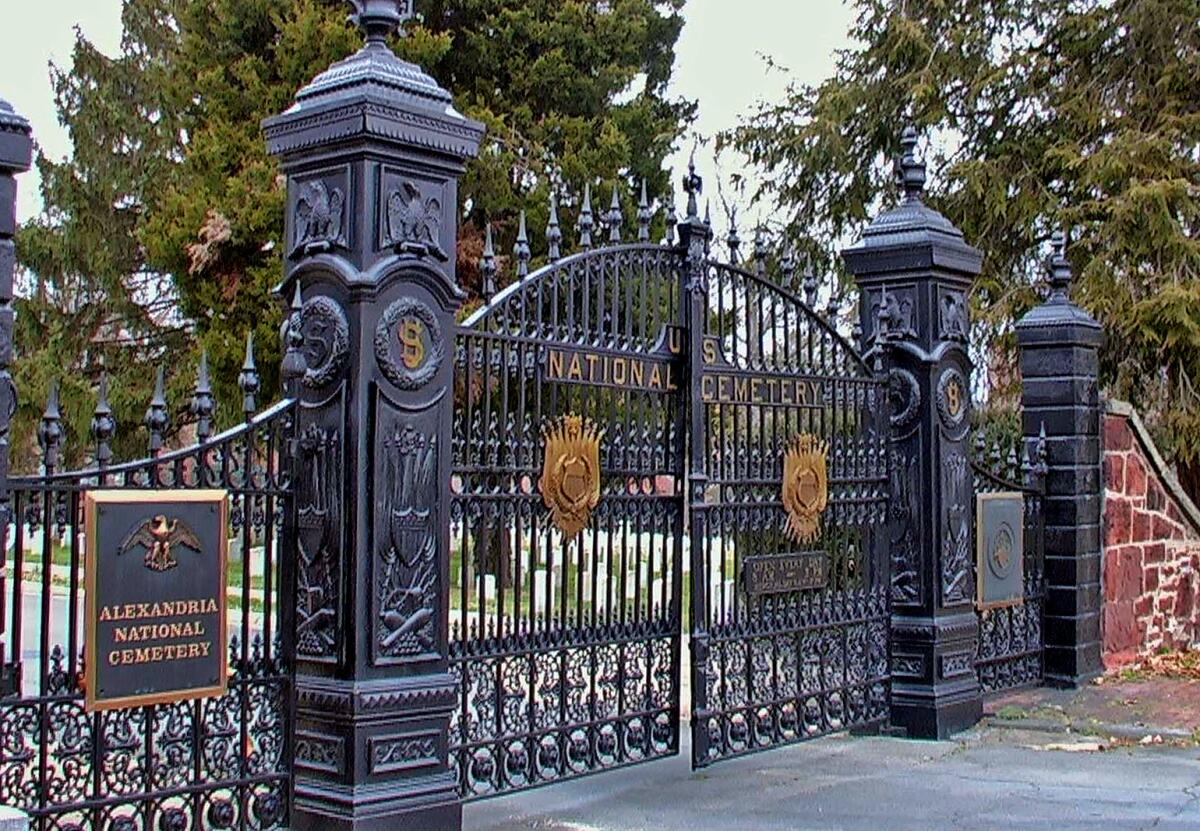
Alexandria National Cemetery, established in a suburb of Washington, D.C., to serve soldiers who died in Union hospitals in the area, was the first national cemetery to bury together black and white soldiers. Read more.
The gates of the Alexandria National Cemetery. (Department of Veterans Affairs )
Alexandria National Cemetery has long served the Union
Name: Alexandria National Cemetery, Alexandria, Va.
Why: All cemeteries tell stories. Some are obvious; others await discovery through hints and clues. Alexandria, established in 1862 as one of the first national cemeteries in the country, has its share.
There's the simple boulder with the bronze plaque memorializing four who drowned in the Potomac River chasing Abraham Lincoln's assassin, John Wilkes Booth. Their graves flank the memorial.
There's the headstone with the name Dolores Mary, wife of Staff Sgt. R.L. Harper, on one side, and on the other the names of her three daughters, ages 4, 2 and 2 months. All died on Nov. 16, 1950 in a fire, we learned later.
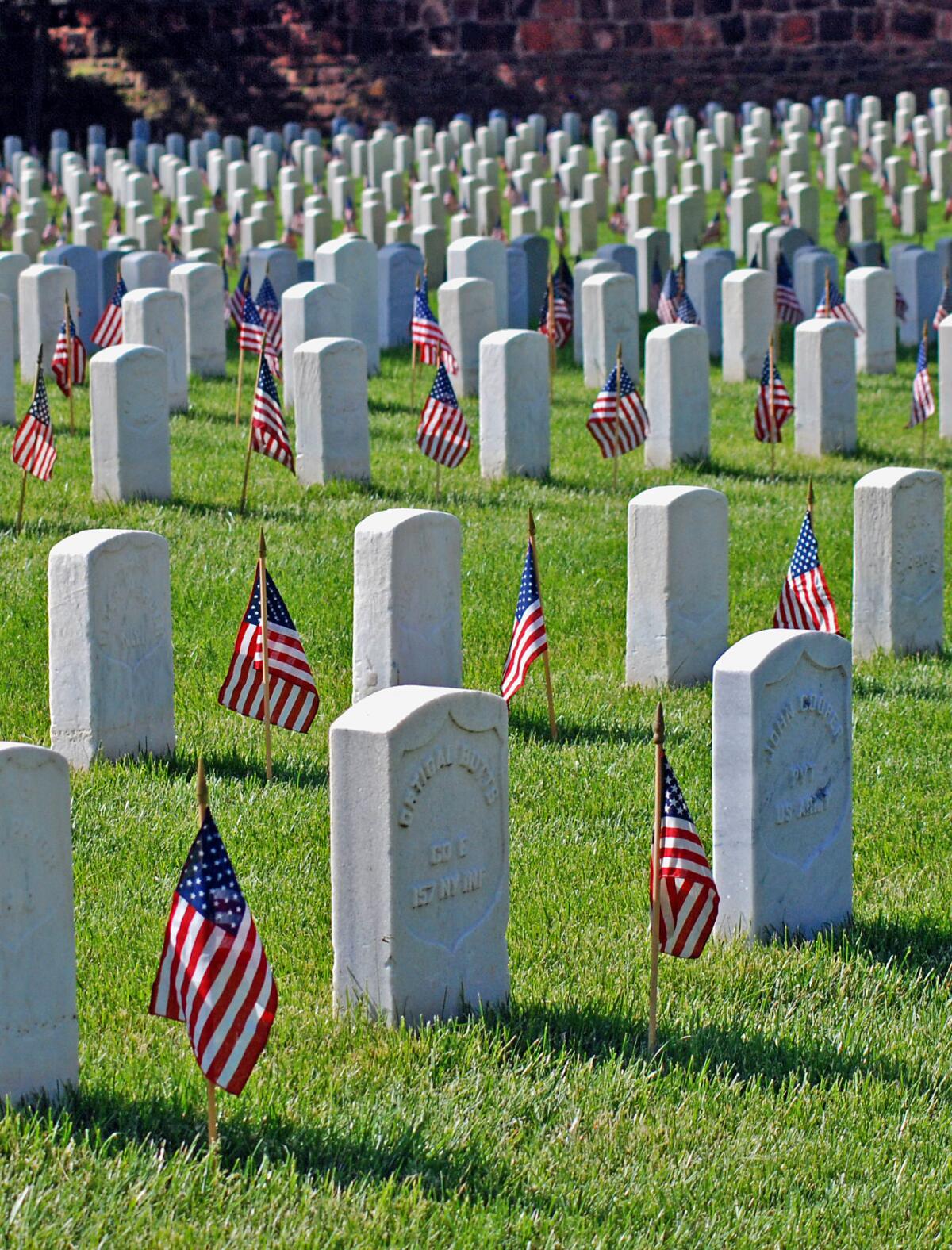
Alexandria National Cemetery
Alexandria National Cemetery. (Department of Veterans Affairs)
And there's the fresh grave of Erdulfo Miguel Cervantes, who died Feb. 27, 2015, at age 32. His headstone identifies him as a "Persian Gulf" veteran, although he served in Iraq and Afghanistan and not the Persian Gulf War of 1990-91.
Alexandria National Cemetery, in a suburb of Washington, D.C., stands out in other significant ways. Established to serve soldiers who died in Union hospitals in the area, it was the first national cemetery to bury together black and white soldiers. Two hundred twenty-nine African Americans, members of the United States Colored Troops during the Civil War, are interred here next to their white brothers-in-arms.
By 1864, the cemetery was almost full, which led to the development of Arlington National Cemetery. The more than 4,500 graves today represent veterans of every major conflict since the Civil War.
Listed in the National Register of Historic Places, the 51/2-acre cemetery is a peaceful spot of gently sloping hills and immaculate grounds with neat rows of uniform white marble headstones. As you stroll the grounds, you can almost hear the voices of the Union Army, which set up camp nearby on the day after Virginia seceded from the Union — each voice with its own tale to tell.
Info: 1450 Wilkes St., Alexandria, Va.; (703) 221-2183, Alexandria National Cemetery
—Veronica Stoddart
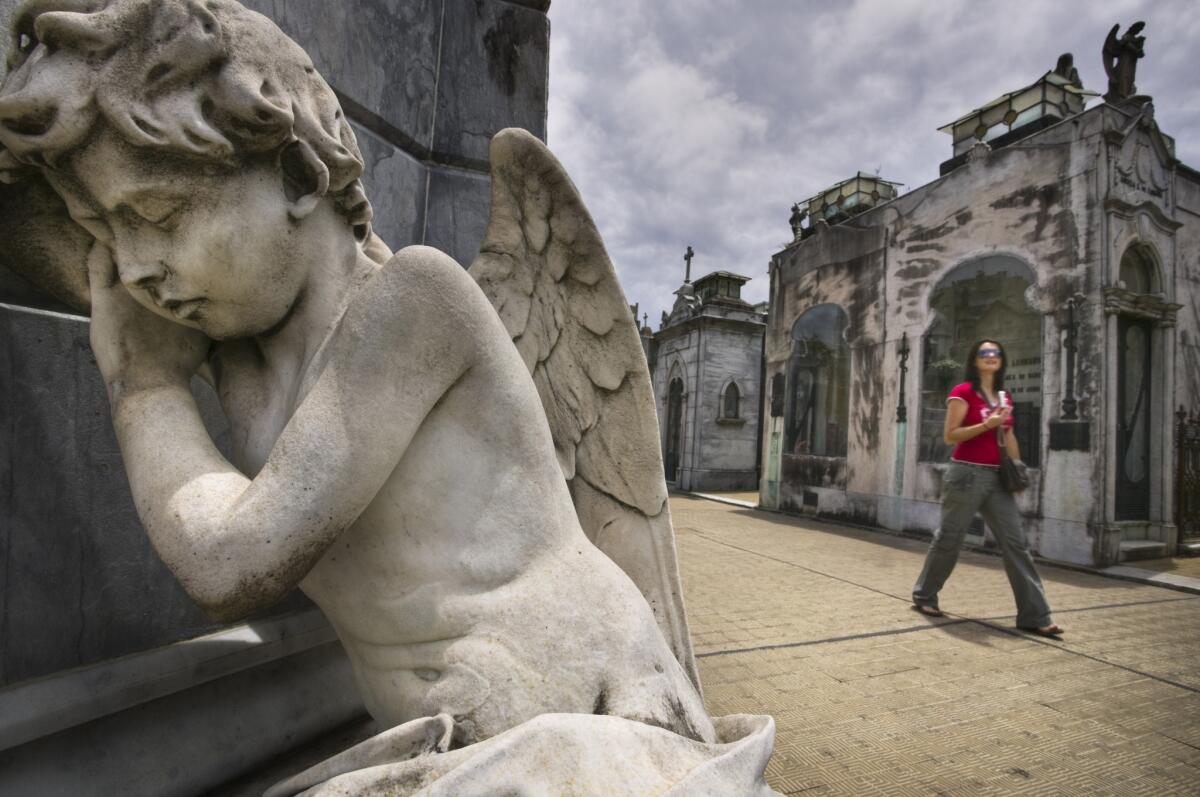
Walking among the tombs in Buenos Aires’ Recoleta Cemetery, known as one of the most interesting cemeteries in the world. Read more.
Walking among the tombs in Recoleta Cemetery (Religious Images / UIG / Getty Images)
La Recoleta Cemetery: Peace, history and Eva Perón
Name: La Recoleta Cemetery, Buenos Aires
Why: La Recoleta, tucked amid the towers and historic manses of Buenos Aires, evokes a Baroque heavenly procession. Cherubs bow in mourning along marbled avenues. Angels, saints and soldiers stand guard on domes and column-lined tombs — about 6,400 — honoring presidents and poets who have been buried in this former convent garden during the last two centuries.
Some visitors come for a respite from the city and for the marbled majesty of these 14 acres. Others come for a history lesson. Besides 18 Argentine presidents, there are actors (Zully Moreno and Armando Bó), writers (Silvina Ocampo and Adolfo Bioy Casares), a Nobel laureate (Luis Federico Leloir, in chemistry), a granddaughter of Napoleon Bonaparte (Isabel Walewski-Colonna) and even a boxer memorialized in his fighting robe (Luis Ángel Firpo).
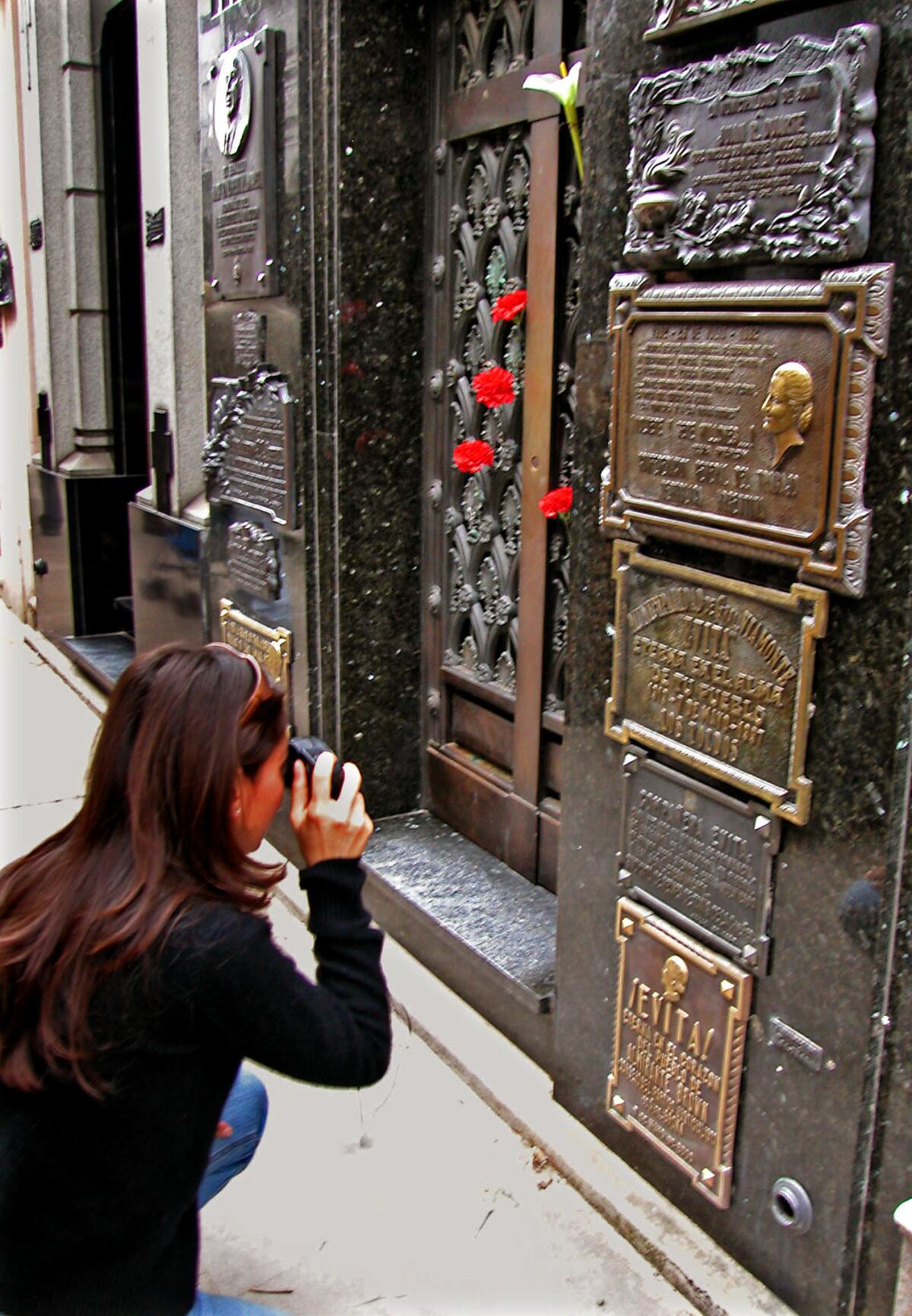
The tomb of Eva Peron in Recoleta cemetery in Buenos Aires, Argentina. She was the second wife of Juan Peron, who was elected president in 1946. She died July 26, 1952.
Eva Perón's tomb in Recoleta Cemetery. (Jane Wooldridge)
But most visitors — especially foreigners — come for a glimpse of one of the cemetery's simpler sepulchers, marked not by statues and carved garlands but by simple bronze plaques. In life, the rich scorned Eva Perón, the fierce actress-turned-first lady born in poverty who championed rights for workers and women. In death, she may be the most famous of them all.
Although both she and her husband, controversial three-time President Juan Perón, were sometimes derided and ostracized, when she died in 1952, the streets were filled with thousands of mourners. Thanks in part to pop culture, Evita lives on — not just in Broadway lore but also in the hearts of those who still lay red carnations at her grave.
Info: La Recoleta Cemetery, 1760 Calle Junín, Buenos Aires. The blog Recoleta Cemetery is a trove for Recoleta devotees.
—Jane Wooldridge
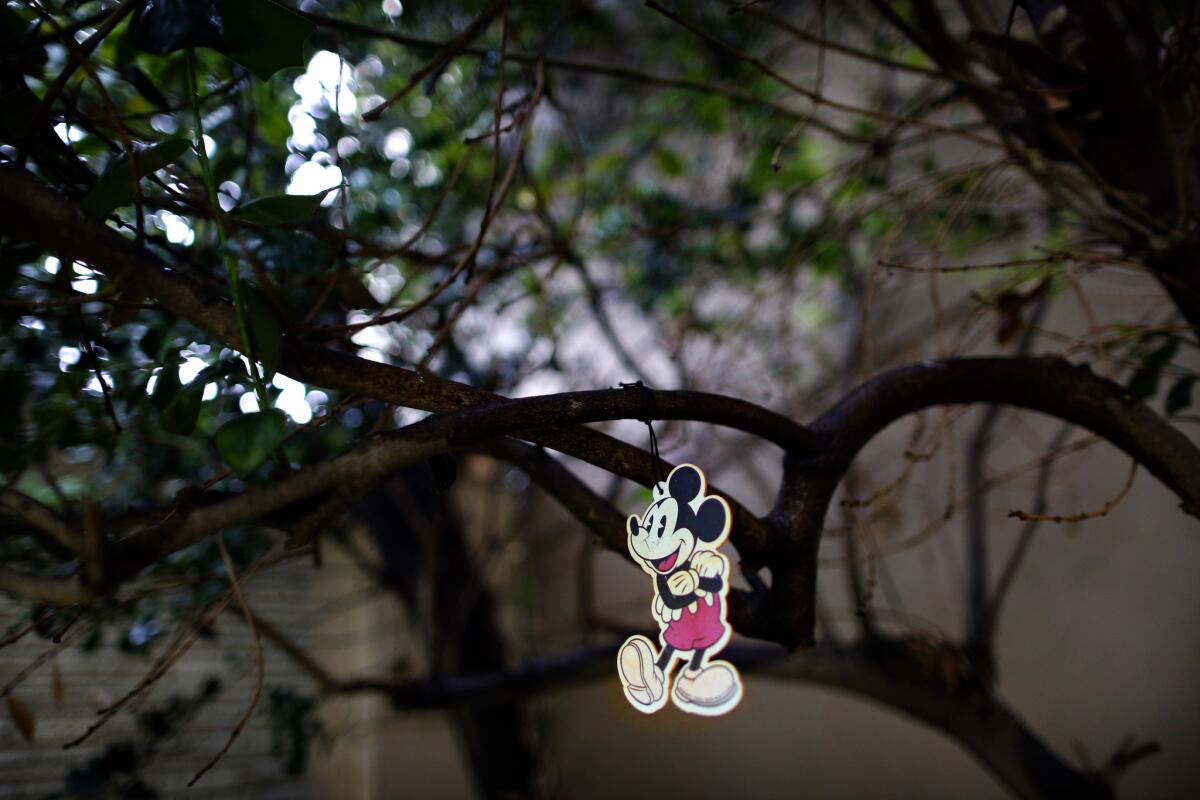
A Mickey Mouse trinket adorns a tree near Walt Disney’s resting spot at
A Mickey Mouse trinket hangs in a tree near Walt Disney's resting spot. (Barbara Davidson / Los Angeles Times)
Forest Lawn Memorial Park: ‘Happy eternal life’
Name: Forest Lawn Memorial Park, Glendale
Why: Los Angeles might have a shorter history than most of the world's major cities, but who has more celebrity cemeteries?
The options in our area include tiny Pierce Brothers Westwood Village Memorial Park (where Marilyn Monroe's marker is often covered in lipstick smudges and Merv Griffin's announces that "I will not be right back after this message"), and the irreverent Hollywood Forever (where a tomb-top bronze statue of Johnny Ramone jams in perpetuity on his electric guitar).
But the mother of them all is the original Forest Lawn in Glendale, founded in 1906. It's the Hearst Castle of cemeteries — a convergence of religion, patriotism, American entrepreneurial pluck and European facsimiles set on about 300 sloping, grassy acres.
Marilyn Monroe, Michael Jackson and more: Seeing celebrities' graves at Los Angeles area cemeteries
The auteur was Hubert L. Eaton, who took over the operation in 1917. By the time Eaton himself was interred here in 1966, he had commissioned copies of just about every known Michelangelo sculpture; a vast reproduction of Leonardo da Vinci's "The Last Supper" in stained glass; and a 195-foot-wide panoramic painting of Christ's crucifixion that was billed as the world's largest religious painting.
Eaton also constructed a free museum and three churches modeled after European landmarks. Ronald Reagan and Jane Wyman married in one of them (Wee Kirk o' the Heather) in 1940.
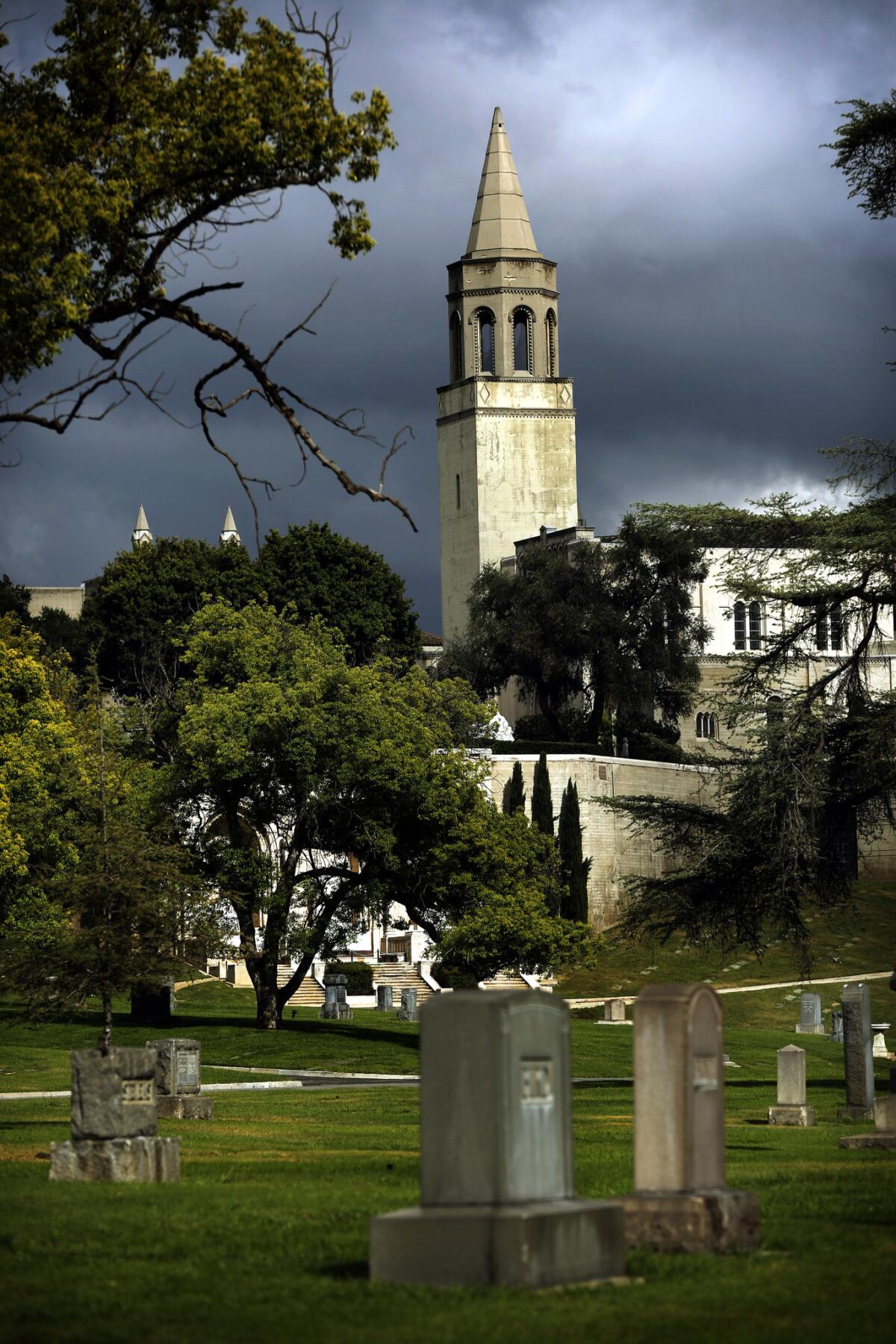
View of the Great Mausoleum at Forest Lawn Cemetery.
View of the Great Mausoleum at Forest Lawn Cemetery. (Barbara Davidson / Los Angeles Times)
"I believe in a happy eternal life," Eaton wrote in the Builder's Creed that is chiseled in stone at the park. "I therefore prayerfully resolve on this New Year's Day, 1917, that I shall endeavor to build Forest Lawn as different, as unlike other cemeteries as sunshine is to darkness, as eternal life is unlike death."
Those sentiments and the grounds have been thoroughly satirized by two British novelists — Aldous Huxley in "After Many a Summer Dies the Swan" and Evelyn Waugh in "The Loved One" — but famous names still arrive regularly.
Among Forest Lawn's permanent residents: Humphrey Bogart, Nat King Cole, Walt Disney, Larry Fine, Michael Jackson, Louis L'Amour, Chico and Gummo Marx, Art Tatum and Elizabeth Taylor. Management gives visitors little or no help in finding celebrity graves, but there are tips aplenty online.
Or you could just browse, bask in the grandiosity of it all and treat any sightings as a bonus.
Info: 1712 S. Glendale Ave., Glendale; (323) 254-3131, Forest Lawn Memorial Park
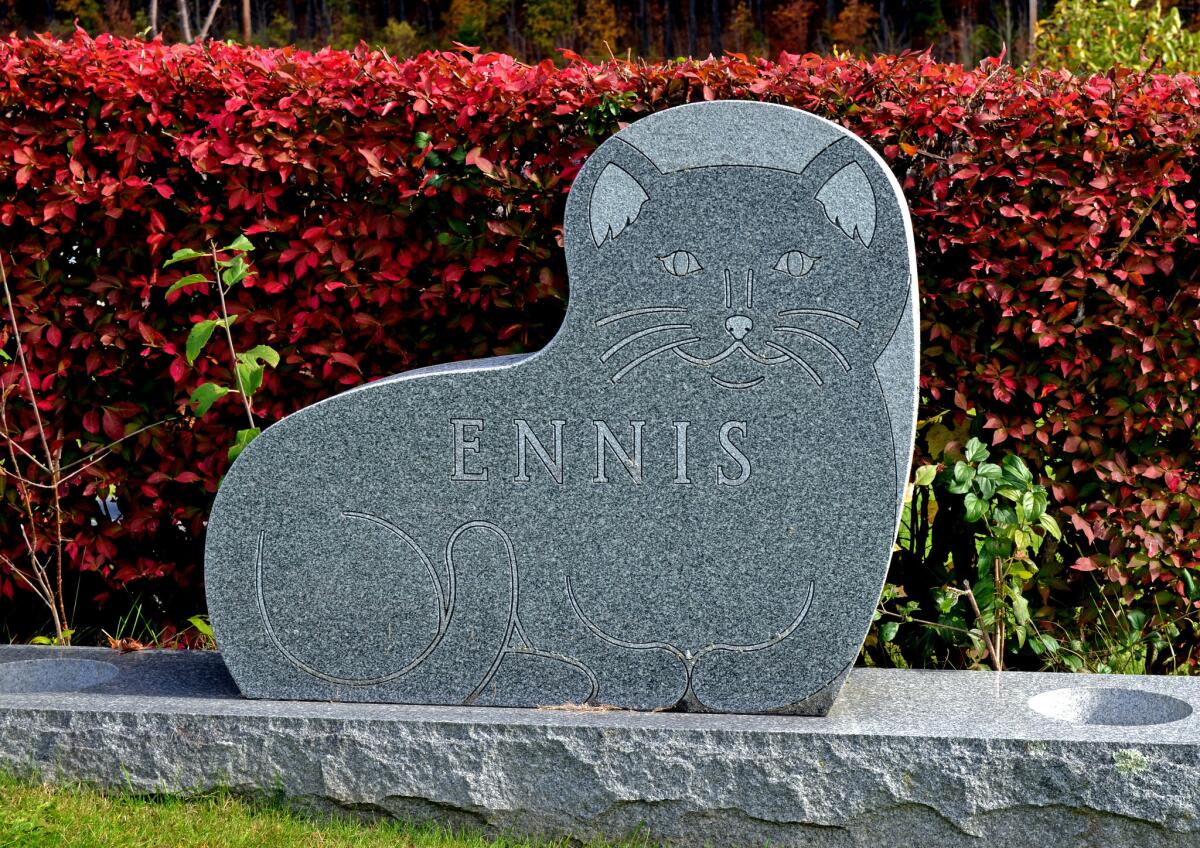
Hope Cemetery also reflects its environment: The area is known for granite mining and expert stonecutters. Read more.
Hope Cemetery welcomes whimsy in good taste with all kinds of fun tombstones.(Doug Hobart)
Hope Cemetery is a whimsical salute to its inhabitants
Name: Hope Cemetery, Barre, Vt.
Why: From the moment you enter the gates of Hope Cemetery, you start to smile … and then laugh out loud. Is this any way to behave in a place where some 10,000 souls are trying to rest in peace?
Well, yes.
More than a cemetery, Hope is a 69-acre sculpture gallery created by the master stonecutters of Barre (pronounced "berry") and a celebration of the lives of those buried there: an old man revving up his motorcycle on his way to the pearly gates, a large soccer ball awaiting kickoff, a biplane banking left toward cloud nine. And a man dying in the arms of his … oh, wait … that's not his wife.
Hope Cemetery opened in 1895 as stonecutters were flocking to Barre, the self-proclaimed Granite Capital of the World because of its flawless Barre Gray granite, still mined from local quarries and shipped worldwide.
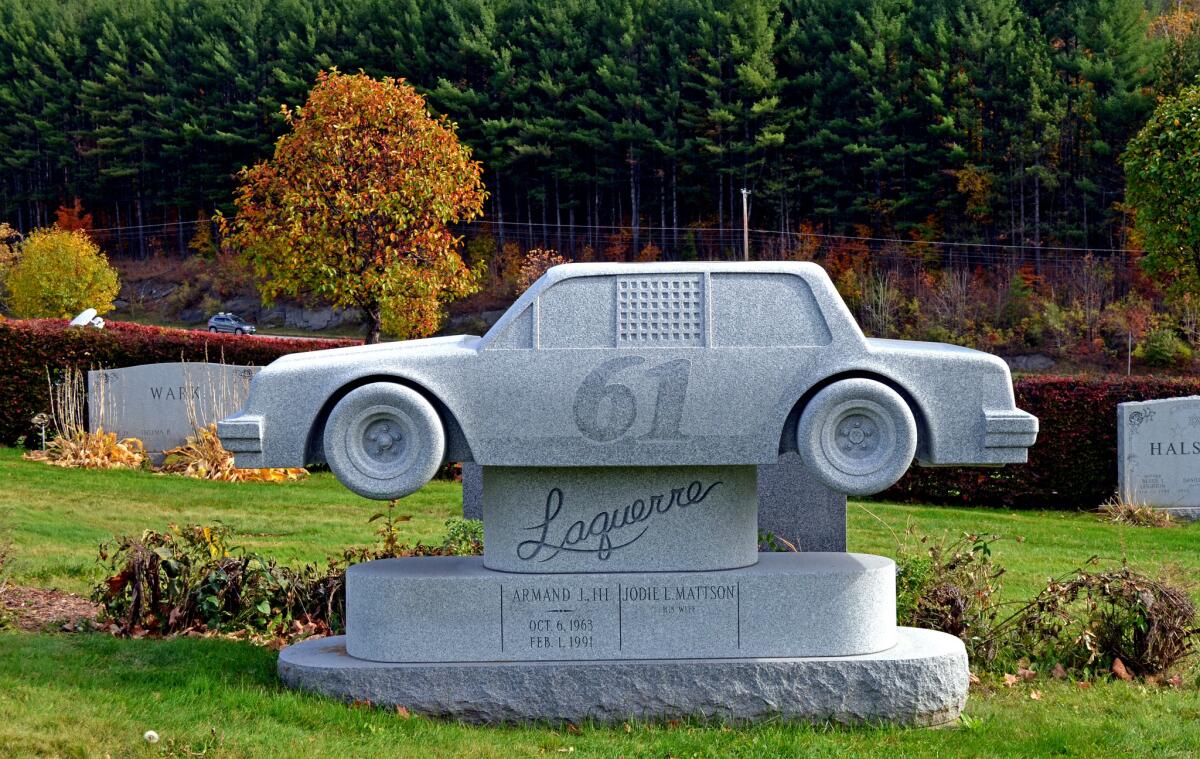
Hope Cemetery in Barre, Vt., welcomes whimsy in good taste with all kinds of fun tombstones. One example: This unique headstone is Joey Laquerre Jr.’s race car. Read more.
Joey Laquerre Jr.'s race car headstone. (Doug Hobart)
One such man was Louis Brusa. He arrived from Italy to work in stonecutting sheds with no ventilation systems, which caused many men to die of silicosis from inhaling granite dust. For years, Brusa led the fight for better working conditions, succeeding in 1936, a year before he died of silicosis at age 51.
In anticipation of the inevitable, many sculptors, including Brusa, designed and carved their own monuments long before they were needed.
"When Brusa's monument was unveiled for the first time at the cemetery, people were shocked," said Ilene Gillander, the cemetery's tour guide. "The woman holding him is not his wife. And she has on a flimsy, skin-tight negligee, which by today's standards, no one would think twice about. But then it was considered pornographic."
These days, city fathers approve designs, welcoming whimsy in good taste. All memorials still must be carved from Barre Gray, to the tune of $2,000 to more than $2 million, according to Todd Paton, director of visitor services for the nearby Rock of Ages granite quarry.
Why not make a day of it: Tour the quarry, where you can watch huge slabs being separated from towering granite walls, then pick up a map for a self-guided cemetery cellphone tour. Or, in advance, call Hope to arrange a small-group cemetery walking tour.
Info: Hope Cemetery, 201 Maple Ave., Barre, Vt.; (802) 476-6245, [email protected]. Rock of Ages, 560 Graniteville Road, Graniteville, Vt.; (802) 476-3119, Rock of Ages.
—Sue Hobart
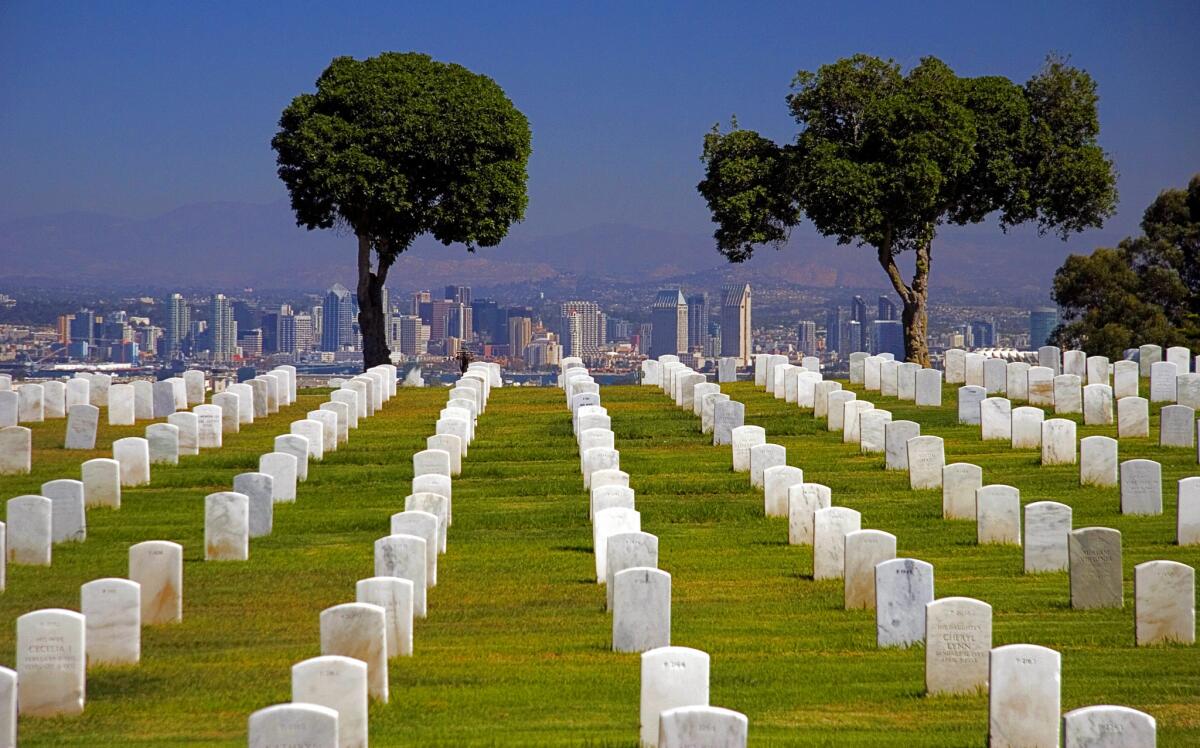
A row of headstones at Ft. Rosecrans National Cemetery, Point Loma, looking toward downtown San Diego. Read more.
A row of headstones looking toward downtown San Diego. (Matthew Micah Wright / Getty Images)
Reflecting on lives of service at Ft. Rosecrans cemetery
Name: Ft. Rosecrans National Cemetery, San Diego
Why: It sits on probably the most valuable piece of real estate in San Diego County: 77 1/2 gently rolling acres atop Point Loma, overlooking San Diego Bay to the east and the Pacific to the west. Stroll among its tidy rows of white gravestones, beneath native Torrey pines and wind-sculpted cypress, and you begin to understand why Smithsonian Magazine lists this among the most beautiful cemeteries in the world.
Today the cemetery is home to about 113,000 veterans and their dependents — dating to 1882, when soldiers who died during the Mexican-American War's Battle of San Pasqual (1846) were reinterred at what is now Ft. Rosecrans. The grounds were registered as a California Historical Landmark in late 1932 and on Oct. 5, 1934, Ft. Rosecrans became a national cemetery.
Other than spaces left for surviving family members of the deceased, the cemetery closed to casket burials in 1966 and to cremated remains a year ago. Still, there are two to 10 burials each day, said cemetery director Douglas Ledbetter. (Veterans and spouses are accommodated in the same grave.)
Like all national cemeteries, Ft. Rosecrans is open to the public from sunrise to sunset daily. More than 1 million visitors come every year, some to attend a committal service or to visit the graveside of a loved one. Others come to pay respects to the 23 Medal of Honor recipients or other military heroes whose remains reside here. (There's an automated grave site locater at the administration building, and maps are available.)
But many come to reflect, to soak up the silence, to settle into the serenity. They come to watch the sun rise over the city or to see it disappear, an apricot smudge sinking into the Pacific.
As they ramble along the rows of gravestones, meticulously aligned like battalions of optimistic young soldiers preparing for battle, they ponder their surroundings and all these thousands of veterans who earned a final resting place here, their families, their stories.
Info: 1800 Cabrillo Memorial Drive, San Diego; (619) 553-2084, Ft. Rosecrans National Cemetery
—Alison DaRosa
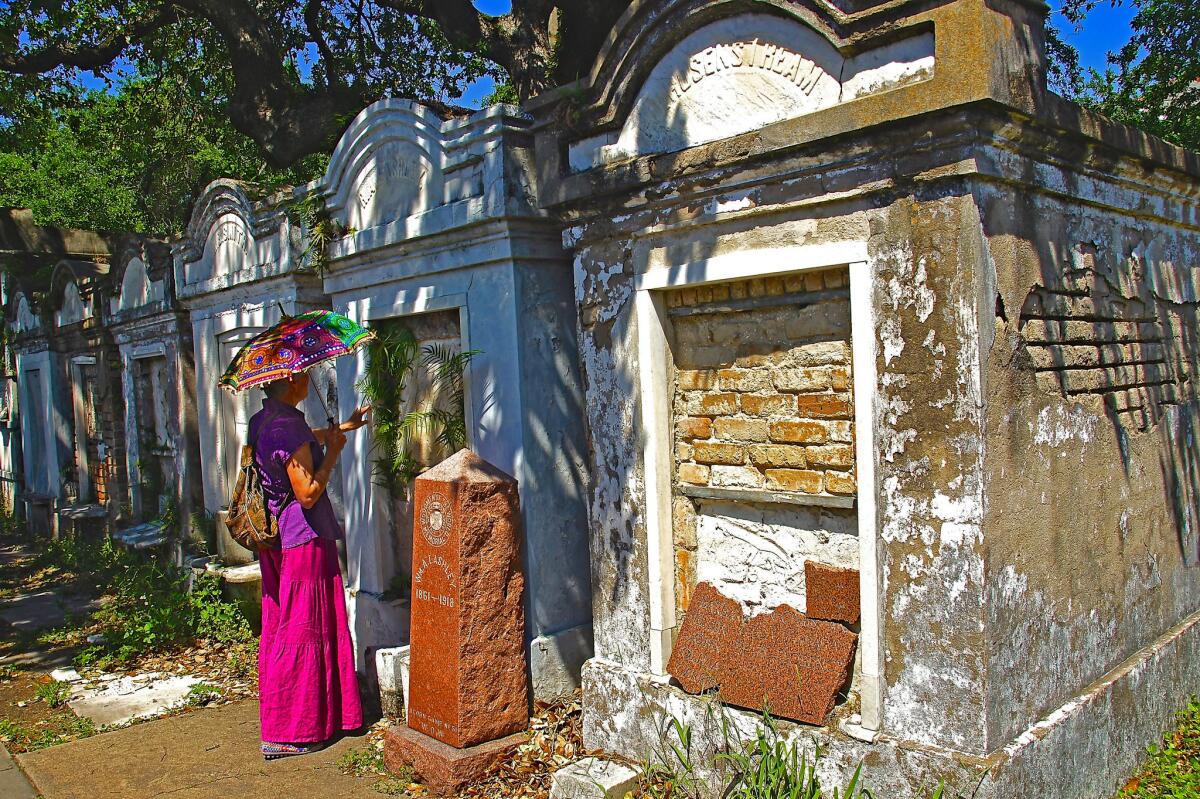
Lafayette Cemetery No. 1 opened in 1833 as New Orleans’ first cemetery laid out on a grid. It has 1,100 tombs, and is still used for burials. Read more.
Lafayette Cemetery No. 1 opened in 1833 as New Orleans' first cemetery laid out on a grid. It has 1,100 tombs, and is still used for burials. (Millie Ball)
Lafayette No. 1 features 19th century tomb architecture
Name: Lafayette Cemetery No. 1, New Orleans
Why: New Orleans is renowned for its cemeteries, but Lafayette No. 1, in the Garden District, is "the one to visit if you can see only one cemetery," said preservationist John Geiser, a volunteer guide with the nonprofit Save Our Cemeteries.
"It's safe and easily accessible and includes examples of every type of 19th century tomb architecture," he said.
Although Lafayette is directly opposite Commander's Palace restaurant, many locals know little about it. I took a tour with Geiser in early May. Lemony-sweet magnolia blossoms scented the humid morning air in the cemetery, a mixture of unkempt and renovated tombs, plastic flowers, weeds, magnolia trees and occasional Mardi Gras beads.
Once part of a plantation, Lafayette was New Orleans' first planned cemetery, opened in 1833 for immigrants, affinity groups and the wealthy, and even today welcomes new occupants weekly into its 1,100 tombs.
Geiser pointed out Christian symbols, such as the lamb atop the John Scheu tomb, which also features the eye of God in a cloud and two women clasping hands over an altar.
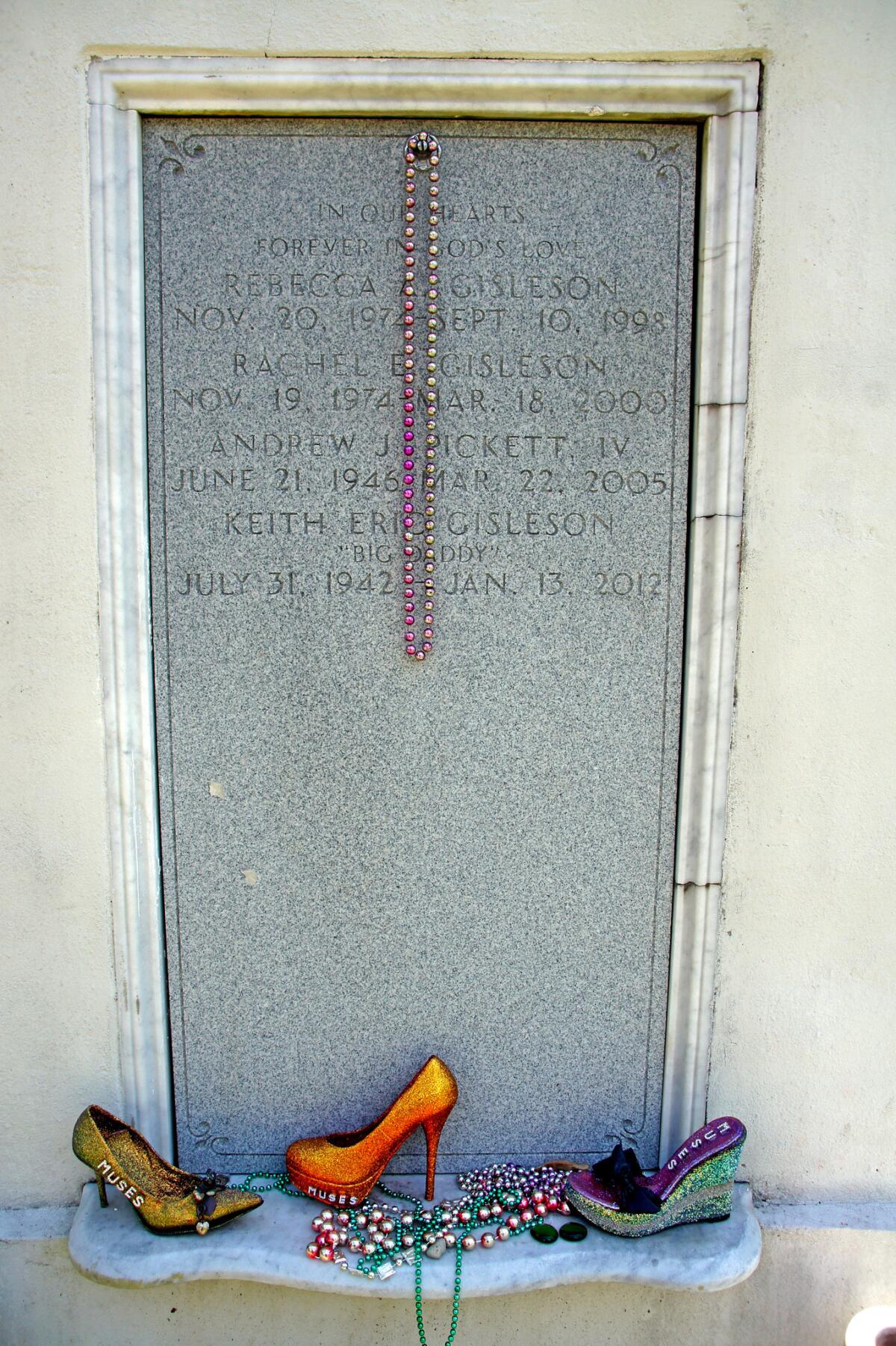
Beads and shoes thrown from the women’s Carnival krewe of Muses adorn this tomb in Lafayette Cemetery No. 1 in New Orleans.
Beads and shoes thrown from the women's Carnival krewe of Muses adorn this tomb in Lafayette Cemetery No. 1. (Millie Ball)
The Earhart resting place is more blunt. Its message is "No cross, No crown," with marble images of the cross and a crown. Buried here is Judge John Howard Ferguson, remembered for Plessy vs. Ferguson, which the U.S. Supreme Court upheld in 1896, approving Louisiana's "separate but equal" segregation law.
Author Anne Rice based the tomb of the Mayfair family on the Jefferson and Lafayette firefighter mausoleum. When her "Memnoch the Devil" was published in 1995, she rode through Lafayette lying in a glass hearse, getting out a block away for an autograph party at the Garden District Book Shop.
Just about everyone says the dead are buried above ground because New Orleans is below sea level. "Not true," Geiser said. "We're standing 8 feet above sea level here." Although half of inhabited New Orleans now is below sea level, much of this part wasn't developed until the 20th century.
Geiser said the earliest graves were holes in the ground by the Mississippi River, but after 20 or 30 years, the French settlers decided to copy the burial style they knew in France — above-ground tombs.
Info: 1416-1498 Washington Ave., New Orleans; Lafayette Cemetery No. 1
—Millie Ball
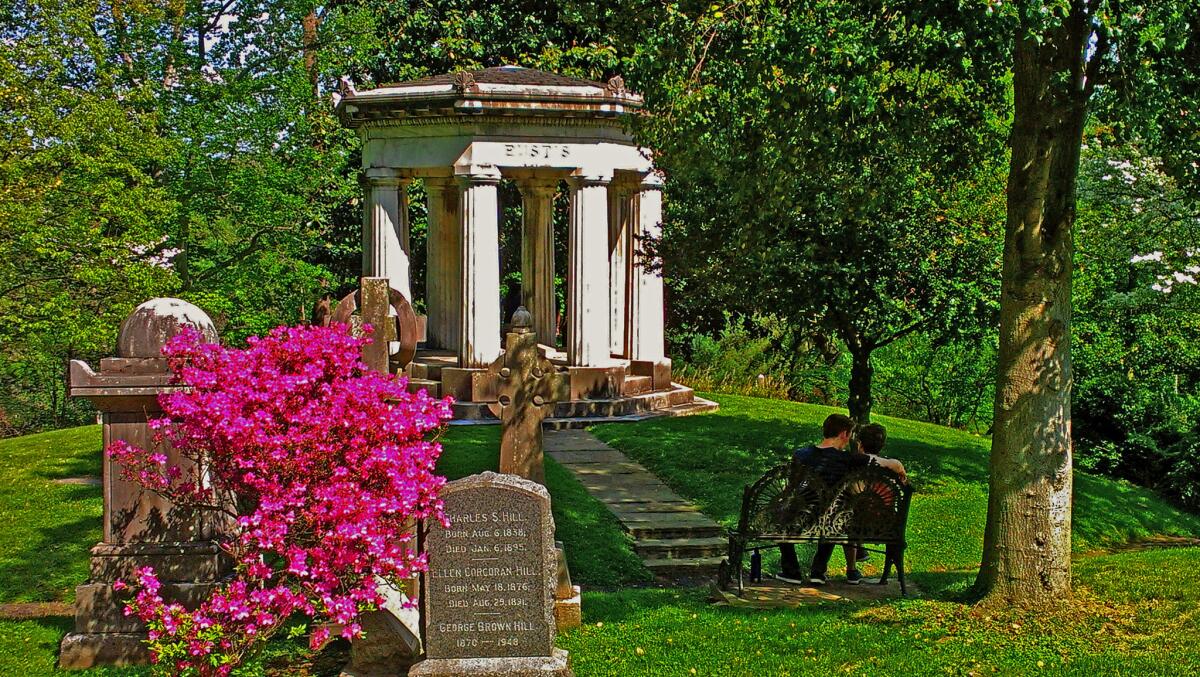
The Corcoran Mausoleum in Washington, D.C.’s Oak Hill Cemetery contains the remains of the cemetery’s founder, philanthropist and art collector William Wilson Corcoran, and other family members. Read more.
The Corcoran Mausoleum contains the remains of the cemetery's founder, William Wilson Corcoran. (Paolo A. Carosso)
A gathering of the power elite at Oak Hill Cemetery
Name: Oak Hill Cemetery, Washington, D.C.
Why: Like the city itself, Oak Hill Cemetery in Washington's tony Georgetown neighborhood is more about power than celebrity. Its rolling terrain harbors politicians, military figures and notable journalists. But only a true wonk would come here seeking headline-worthy epitaphs.
Instead, Oak Hill is remarkable for its topography. In a region of noteworthy burial spots (Congressional Cemetery, Arlington National Cemetery), this 25-acre idyll stands out as one of the capital's loveliest under-the-radar gardens. Azaleas and boxwood line meandering paths that cascade to adjacent Rock Creek Park. Centuries-old white oaks tower above. Wrought-iron garden benches beckon visitors to linger.
"You'd never build a cemetery on a site like this," said Oak Hill superintendent Dave Jackson from a perch overlooking Rock Creek. "It's all hills and valleys. You can't get a backhoe in so all the graves are dug by hand with picks and shovels."
You could say Oak Hill's founder, philanthropist and art collector William Wilson Corcoran, chose this challenging spot because he could. He made a fortune selling government bonds that financed the 1846-48 Mexican-American War.
The rural cemetery movement was blossoming in mid-19th century America at a time when church graveyards were filling up and the concept of public parks had yet to take root. Oak Hill is a prime example of the era's so-called garden cemeteries, where visitors might pay their respects, then settle down for a picnic among the tombstones.
Corcoran commissioned architect James Renwick, designer of St. Patrick's Cathedral in New York and Washington's original Corcoran Gallery of Art (now the Smithsonian's Renwick Gallery), to create the cemetery's Gothic Revival chapel, one of two Oak Hill structures on the National Register of Historic Places.
Among notable proceedings in the red sandstone chapel: Willie Lincoln's pre-burial service. Abraham Lincoln's son, who died in 1862, was interred in the cemetery's Carroll family vault for three years, and Lincoln visited frequently, Jackson said. In April 1865 the boy's coffin was loaded onto the assassinated president's Springfield, Ill.-bound funeral train.
The Carroll mausoleum is one of Oak Hill's most asked-about sites, but it's just one of hundreds of spectacular memorials here. Many are artful, such as the 1927 Tiffany Studios monolith etched with the ethereal image of an angel. Some record a curriculum vitae, such as the one that begins: Co-founder of Czechoslovakia-Envoy of France-Pillar of the League of Nations-Advisor to U.S. Presidents....
And one marker celebrates a lesser but no less proud achievement. "We finally found a place to park in Georgetown," it says.
Info: 3001 R St. N.W., Washington, D.C.; (202) 337-2835, Oak Hill Cemetery
—Jayne Clark
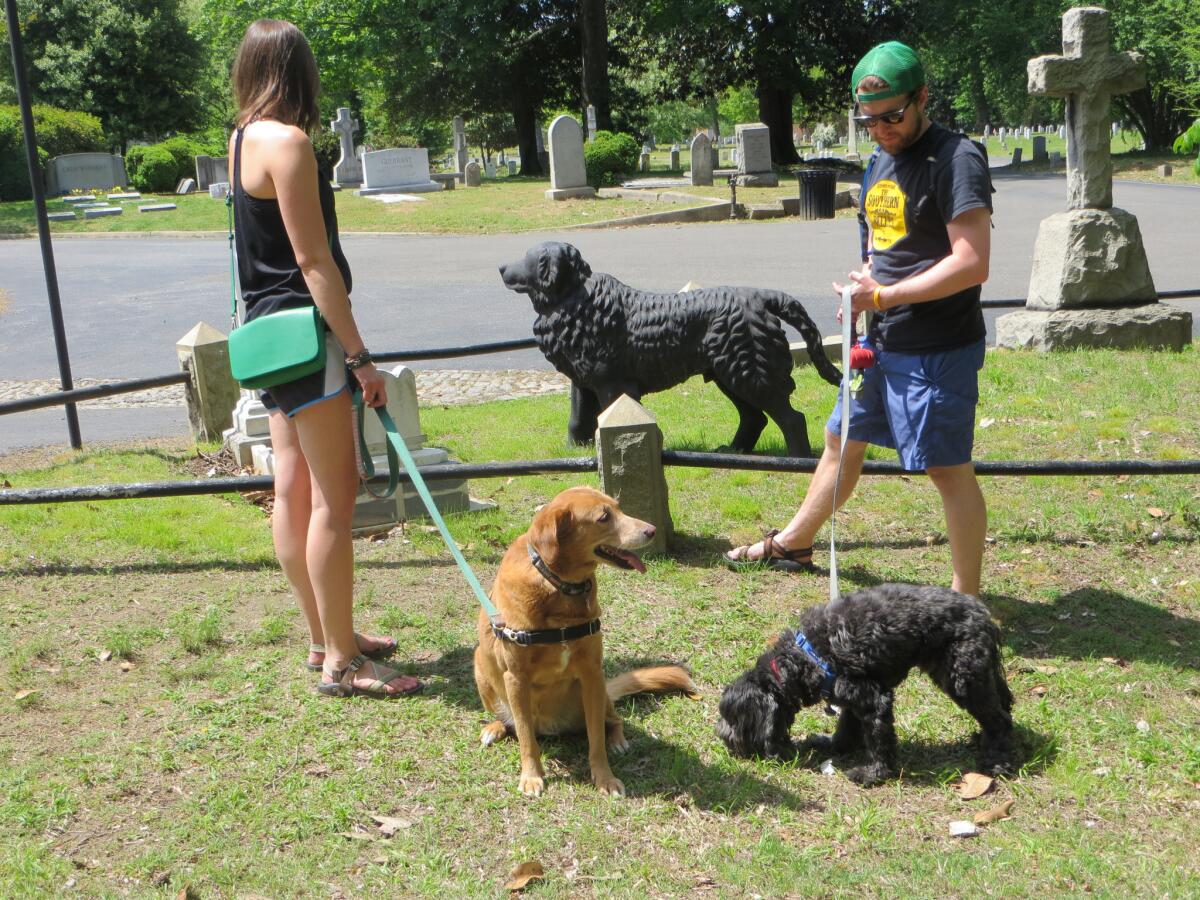
The life-size Newfoundland dog statue at Hollywood Cemetery in Richmond, Va., stands at the grave of 2-year-old Florence Bernadine Rees, who died during the Civil War. People feel moved to leave objects within the tiny confines of the grave’s stone edging. Read more.
The life-size Newfoundland dog statue stands at the grave of 2-year-old Florence Bernadine Rees, who died during the Civil War. (Katherine Calos)
Hollywood Cemetery hosts presidents, cast-iron dog
Name: Hollywood Cemetery, Richmond, Va.
Why: You would expect to see the resting places of presidents and Confederate leaders marked on the map of a historic cemetery in Richmond, but what might surprise you is a cast-iron dog, which draws almost as much attention to the grave of a little girl who died during the Civil War.
The life-size Newfoundland at Hollywood Cemetery stands at the grave of 2-year-old Florence Bernadine Rees, who died of scarlet fever on Feb. 7, 1862. People feel moved to leave objects within the tiny confines of the grave's stone edging, though it's not clear whether they're for the child (a doll), the dog (a flying disk) or a personal tragedy (a Virginia Tech hat).
The cast-iron dog was created in the 1850s by a Baltimore foundry and stood for years at a Richmond storefront, possibly that of photographer Charles R. Rees, whose name is on the cemetery plot. Children then, as now, loved the statue. After little Bernadine died, her Uncle Charles moved the dog to the cemetery to guard over her grave.
His motives may not have been completely altruistic, because by moving the dog to the cemetery he also was protecting it from the Confederate war effort.
"They were melting down everything they could find," tour guide E.L. Butterworth said on a trolley tour during the annual Friends of Hollywood Cemetery picnic. Cemetery monuments, though, were exempt from confiscation. "Rees worried about his dog," Butterworth said. "So he brought it to the plot."
Scattered around the cemetery are five other statues of dogs, Butterworth said, but they don't inspire the same lore. Two dogs also may be buried with Pulitzer Prize-winning novelist Ellen Glasgow, if her request was honored at her death in 1945.
More than 80,000 people are buried in the sprawling cemetery park, which was inspired by Père Lachaise in Paris. When established in 1847, Hollywood was outside the city limits. The first burial took place in 1849.
The cemetery's famous residents include three presidents — U.S. presidents James Monroe and John Tyler and Confederate President Jefferson Davis — and Confederate war leaders Gens. J.E.B. Stuart, George Pickett, John Pegram and John Imboden and naval officer Matthew Fontaine Maury.
After the end of the Civil War in 1865, ladies of the Hollywood Memorial Assn. raised $18,000 to build a 90-foot granite-block pyramid as a monument to the more than 18,000 Confederate soldiers buried here.
Near the pyramid stands the cast-iron dog, an endearing and enduring testament to our love for our children and our dogs.
Info: 412 S. Cherry St., Richmond, Va.; Hollywood Cemetery, (804) 648-8501.
—Katherine Calos
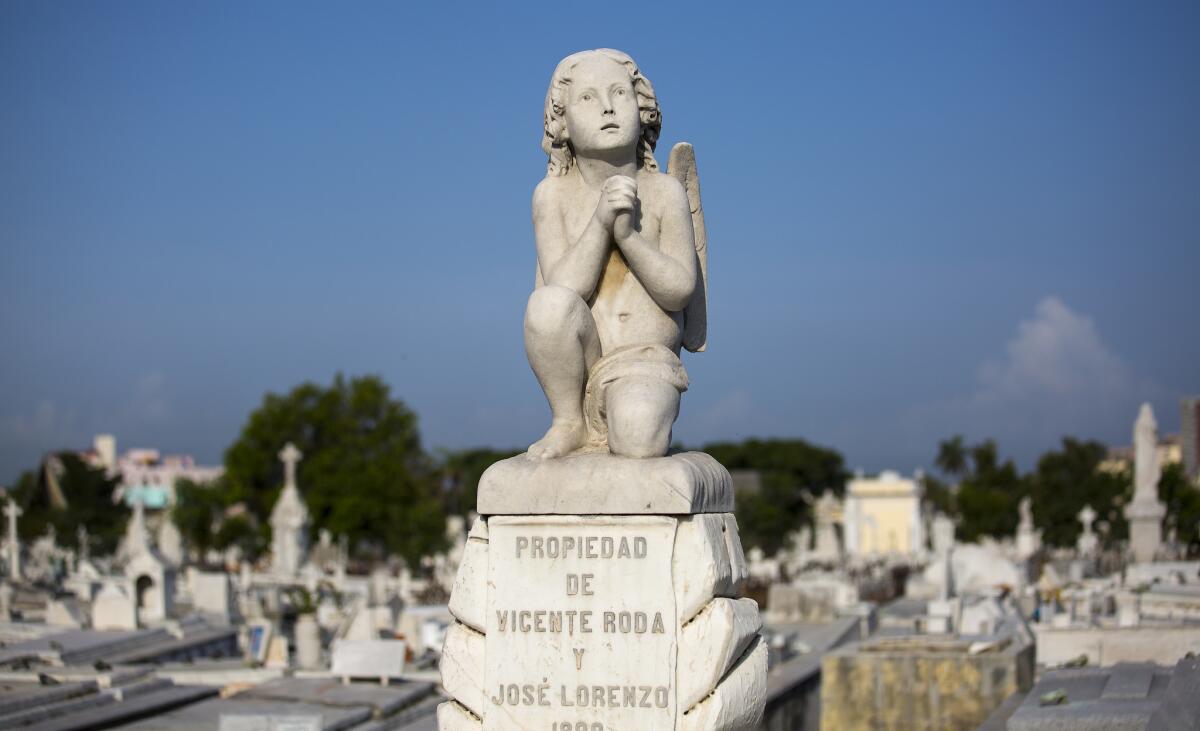
A grave marker at Cementerio de Cristóbal Colón in the Vedado neighborhood of Havana. The Colón Cemetery was founded in 1876. Read more.
A grave marker at Cementerio de Cristóbal Colón, which was founded in 1876. (Brian van der Brug / Los Angeles Times)
Tale of a mother's enduring love told at Havana cemetery
Name: Cementerio de Cristóbal Colón, Havana
Why: In Victorian times, cemeteries weren't just for funerals or Memorial Days. People treated them more like parks. You might stroll in one, admire the monuments or even picnic, whether or not you had relatives buried there.
That sounds a lot like modern sightseeing, which may explain why it doesn't feel ghoulish to wander around Havana's Cementerio de Cristóbal Colón. Either that or the fact that it's often so full of visitors that it looks like a block party.
Like Recoleta in Buenos Aires, Père Lachaise in Paris and the above-ground cemeteries of New Orleans, Havana's huge cemetery — named for Christopher Columbus, who wasn't buried in it — is crowded with memorial sculptures and architectural fantasies. And because generation after generation may be interred in the same tomb, the whole place is full of family stories.
A few of those stories make it to tourist ears, giving the dead an unexpected afterlife. The most famous is the story of La Milagrosa — the lady of miracles.
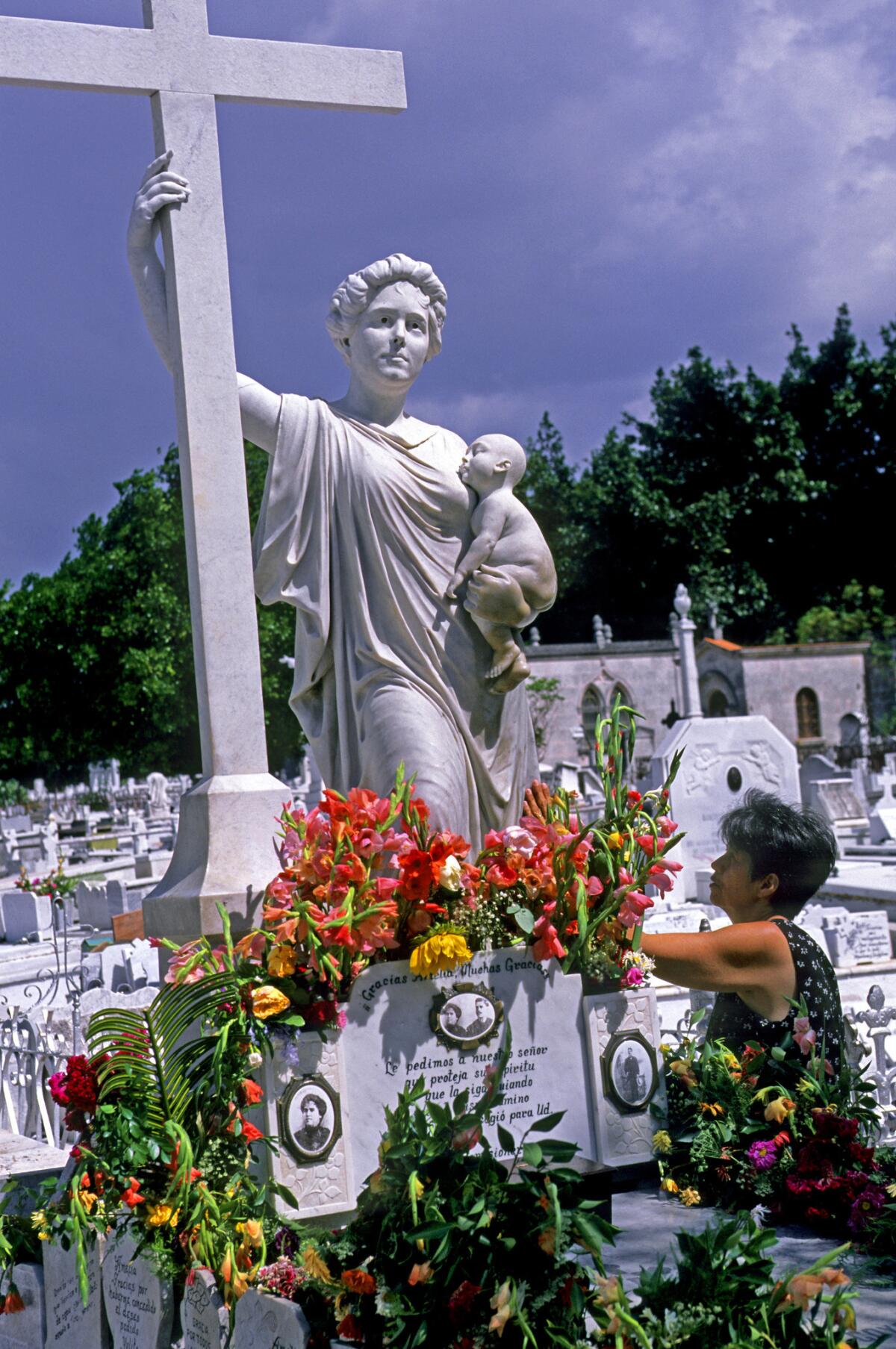
The Grave Of Amelia in Havana's huge cemetery. (Wolfgang Kaehler / LightRocket / Getty Images)
She was Doña Amelia Goyri de la Hoz, who died in childbirth in 1901 at age 24. Her infant son died with her. They were buried together, Doña Amelia laid out as if she were sleeping, baby at her feet.
Her husband never stopped grieving. He visited her tomb every day, knocking on it as if it were a door, calling to her. Years later, he had the tomb opened so he could see her one more time, and by then a miracle had taken place:
The baby wasn't at her feet anymore. The baby was in her arms.
The tomb quickly became a place of pilgrimage for pregnant women, worried parents, whole families and now tourists. It's marked with a white marble statue of a woman holding a cross in one arm, a baby in the other, and it's always smothered in flowers, notes and mementos. You can't miss it.
You shouldn't insult it, either. La Milagrosa's husband never turned around when he left — he just backed away, his eyes fixed on her resting place. Visitors are expected to do the same.
Info: Calle Zapata and Calle 12 in Havana's Vedado neighborhood.
—Catherine Watson
Sign up for The Wild
We’ll help you find the best places to hike, bike and run, as well as the perfect silent spots for meditation and yoga.
You may occasionally receive promotional content from the Los Angeles Times.
